Text
Reblogged by Shane Lehane Sheelah take a bow: St Patrick’s wife? Probably not – she was far more important than that
A symbol of Irish womanhood, she deserves to be celebrated again every March 18th

The 16th, 17th (St Patrick’s Day) and 18th March: Erskine Nicol’s painting of the Irish celebration that included Sheelah’s Day. Photograph courtesy of the National Gallery of Ireland
Shane Lehane
Fri Mar 15 2019 - 06:00
For hundreds of years Ireland has had an icon of womanhood and a compelling symbol of all things female, yet few people know her name. The forgotten goddess is none other than Sheelah, once widely celebrated on March 18th, both in Ireland and among the diaspora, yet now all but disappeared. Fáilte Ireland should start to champion her alongside St Patrick: she could be worth a fortune.
Two years ago my research into this disregarded deity resulted in somewhat misleading headlines that said Sheelah was St Patrick's wife. That was not the case, but at least it brought Sheelah and her festival back to our attention. I believe Sheelah – or Sheila, Sheela, Shela, Sheelagh or Síle, depending on the source – has far more to her than the once widely held belief that she was our national saint's other half.
Sheelah's Day fell each year on March 18th, and the usual dispensation to disregard Lenten abstinence on March 17th and wet the shamrock – drink alcohol, in other words – in honour of St Patrick was extended to the following day as well, in honour of his so-called wife. The Freeman's Journal of March 20th, 1841, reported that a woman who appeared in court for drunkenness declared she bought "two small naggin of whiskey… not wishing to break through the old custom of taking a drop on St Sheelah's Day". In contrition to the judge, she vowed: "I here promise that for Patrick's Day or Sheelah's Day, or any other day in the calendar, I'll never stand in your presence again."

Some say Sheelah was 'Patrick's wife', others that she was 'Patrick's mother', while all agree that her 'immortal memory' is to be maintained by potations of whiskey
A painting by Erskine Nicol from 1856, depicting the revelries of such mid-Lenten festivities, is accurately entitled The 16th, 17th (St Patrick’s Day) and 18th March. This elongated name recognises that most Irish festivals, including fairs, pattern days and wakes, took place over three days: the gathering, the feast and the scattering. Sheelah’s Day was the last (but not the least) of the traditional three days of celebration that began on the eve of St Patrick’s Day.
William Hone gives a detailed account of Sheelah’s Day celebrations in Britain in The Every-day Book, from 1827.
“The day after St Patrick’s Day is ‘Sheelah’s day’, or the festival in honour of Sheelah. Its observers are not so anxious to determine who ‘Sheelah’ was, as they are earnest in her celebration. Some say she was ‘Patrick’s wife’, others that she was ‘Patrick’s mother’ while all agree that her ‘immortal memory’ is to be maintained by potations of whiskey. The shamrock worn on St Patrick’s day should be worn also on Sheelah’s day, and on the latter night, be drowned in the last glass. Yet it frequently happens that the shamrock is flooded in the last glass of St Patrick’s day, and another last glass or two or more on the same night, deluges the over-soddened trefoil. This is not ‘quite correct’ but it is endeavoured to be remedied the next morning by the display of fresh shamrock, which is steeped at night in honour of ‘Sheelah’ with equal devotedness.”

This festive time coincides with the vernal equinox, one of the two midpoints of the sun’s annual cycle, in the season of new fertility, when days are poised to outlast nights for the first time since the autumn equinox, the previous September. An emphasis on new life and procreation is manifest in a host of mythological incarnations and folk reflexes at this time of the year. The goddess and holy woman Brigid is celebrated on February 1st; the analogous figure of Gobnait, goddess of fertility and beekeeping, is commemorated on February 11th. These women usher in the new cycle of fertility with ploughing, sowing, the birth of animals, the rising of the sap and the reawakening of nature.
This time of year in the past brought an equal emphasis on human marriage and reproduction, with Shrove Tuesday, immediately before Lent, long being the most popular day in Ireland to be married.
The three-day carnival celebrating Patrick and Sheelah occurs at this key point in the calendar and in the annual cycle of fertility. That Sheelah is firmly situated around the equinox, the seminal pivot of fertility, indicates that she had distinct fertility associations and can be viewed as an equivalent to Brigid and Gobnait.
Patrick is fighting with his wife, now a miserable hag at war with the world. She spitefully brushes the last of the winter snow into the way of the new cycle of work
Sheelah still echoes through Newfoundland, otherwise known as Talamh an Éisc, or Land of the Fish, the most Irish place outside Ireland. An amazing legend on this Canadian island, which many still believe to be true, centres on Sheila na Geira, or Síle Ní Ghadhra, a young Irish princess from Connacht. Sometime in the 1600s, when she was en route to a French convent to finish her education under the care of her abbess aunt, pirates commandeered her ship. One of them, Gilbert Pike, from a well-to-do English family, fell in love with her. They married aboard and then settled down in Mosquito, in southwestern Newfoundland. Here, in time, Sheila na Geira gave birth to a child – according to tradition the first white European child to be born in Newfoundland – so it is said that many there owe their lineage to her. It is also said that every Irishman who visited and settled on Newfoundland paid obeisance to Sheila na Geira, who reportedly lived to 105.

In Ireland, especially from the mid-18th century onwards, Síle Ní Ghadhra was one of the most popular representations of the country, and in the aisling, or dream, poetry of the period she epitomises Ireland in its idyllic state: strongly independent, bountiful and fertile. In this sense Sheila joins the many women sovereignty figures who represent Ireland: Ériu, Fódla, Banba, Aoibheall, Clíodhna, Macha, Mór and Mórrígan, to name a few (and not forgetting the Christianised figures of Brigid and Gobnait).
In keeping with her mother-goddess attributes, the last big snowstorm after St Patrick’s Day is still called Sheila’s brush in Newfoundland. The idea is that Patrick is fighting with his wife, now a miserable hag at war with the world. (The idea that Patrick had a wife called Sheila must have arrived with the Irish of the 18th and 19th centuries.) She spitefully brushes the last of the winter snow into the way of the new cycle of work.
It’s significant that Síle na géag, or Sheila of the brush, is one way to render Sheela-na-gig, the name for the naked old woman who appears, exposing her genitals, in medieval stone carvings. We’ll return to this. As for the Newfoundland Sheila’s brush, sealing fleets would refuse to go back out on the ice until this storm had passed; fishermen continue to do so.

Sheila’s brush: Newfoundland fishermen would wait for the first snowstorm after St Patrick’s Day to pass before going back out to sea. Photograph: NFB/Getty
Sheelah is an enigmatic name. It and all its variant spellings appear only about 500 times in the 1911 census of Ireland. By contrast its English equivalent, Julia, has almost 30,000 entries. Similarly, no Sheilas appeared on the manifests for ships taking women convicts to Australia, even though the name has entered the language there as jocular but mildly pejorative slang for a woman or girlfriend.
That Freeman’s Journal court report from 1841 refers to the defendant as “a half-naked, wretched looking old woman” who was “charged with having been found drunk and incapable in the street”. The headline was “A Sheelah’s Forethought”. This and many other references made “Sheelah” a byword for a bedraggled old woman.
But elderly women also had experience of the world and were custodians of inherited knowledge, playing significant roles in rites of passage in the human life cycle and the cycle of the year. They acted as midwives, corpse washers and professional mourners; they advised on herbalism and vernacular medicine; and they were central to events such as the pattern day. In this respect Sheelah, as the old woman, is strongly resonant of the important Irish folk figure known as the Cailleach.
The Cailleach – the old, wise healer – is a multifaceted personification of the female cosmic agency. Irish mythological, historical and folkloric expressions cast her as the expression of the territorial- and tribal-sovereignty queen and as the life force inherent in nature, nurturing and maternal but also terrifying and destructive.
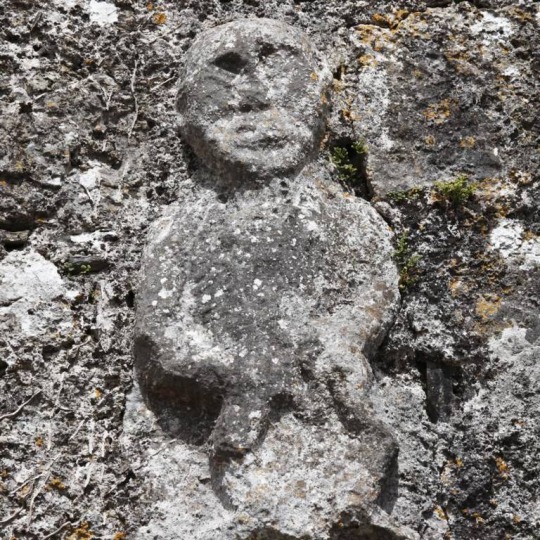
Sheela-na-gig: the medieval stone carvings show folk deities associated with birth and death. Photograph: Getty
The Cailleach tradition’s deep roots in ideas of birth, fertility and death brings us back to the Sheela-na-gig. Ireland has more than 100 examples of these often-misunderstood medieval stone carvings. The women in them, who are reclining or squatting, often have big ears, long hair, gritted teeth, emaciated ribs and prominent breasts.
They often appear on medieval tower houses, medieval church sites and holy wells. I recently came across one on a round tower in Rattoo, in Co Kerry. For a long time they were seen as representations of the evils of lust or as ways of averting the “evil eye”. But Sheela-na-gigs are more convincing, in line with the Cailleach, as folk deities associated with birth and death. And so Sheelah embodies the cycle of fertility that overarches natural, agricultural and human procreation and death.
That Sheelah was thought of as St Patrick’s wife is a significant folk reflex. The cult of Patrick is firmly based on the pre-Christian deity Lug, or Lugh – as in Lughnasa or Lúnasa, the harvest festival – who represents the male side of the life-giving equation. Lug personifies the ideal man, exemplified in the complex ideology of Irish kingship. It is the union of male and female that allows us to exist.

It should be no surprise, then, that the three-day carnival to celebrate St Patrick, a major Christian icon, at the liminal point of the season of fertility, when human procreation is paramount, should include Sheelah, his consort.
As many of her devotees died in the Famine, and given the influence of the misogynist, patriarchal church, she has all but vanished from Irish life. I, for one, will be raising a glass to her on her feast day.
Shane Lehane teaches archaeology, folklore and history at CSN College of Further Education, in Cork, and lectures in the department of folklore and ethnology at University College Cork. He is always interested to hear about local folk custom and tradition; you can email him at [email protected]
I hope you enjoyed this Reblog more to come soon
Regards,
Culture Calypso’s Blog
2 notes
·
View notes
Text
Todays blog is on Litha Summer Solstice enjoy!
🌻🌞🌻🌞🌻🌞🌻🌞🌻🌞🌻🌞🌻🌞🌻🌞🌻
An Ancient Solar Celebration
Nearly every agricultural society has marked the high point of summer in some way, shape or form. On this date–usually around June 21 or 22 (or December 21/22 in the southern hemisphere)–the sun reaches its zenith in the sky. It is the longest day of the year, and the point at which the sun seems to just hang there without moving – in fact, the word “solstice” is from the Latin word solstitium, which literally translates to “sun stands still.” The travels of the sun were marked and recorded. Stone circles such as Stonehenge were oriented to highlight the rising of the sun on the day of the summer solstice.
Did You Know?
Early European traditions celebrated midsummer by setting large wheels on fire and then rolling them down a hill into a body of water.
The Romans honored this time as sacred to Juno, the wife of Jupiter and goddess of women and childbirth; her name gives us the month of June.
The word “solstice” is from the Latin word solstitium, which literally translates to “sun stands still.”
Traveling the Heavens
Although few primary sources are available detailing the practices of the ancient Celts, some information can be found in the chronicles kept by early Christian monks. Some of these writings, combined with surviving folklore, indicate that Midsummer was celebrated with hilltop bonfires and that it was a time to honor the space between earth and the heavens.
Angela at A Silver Voice says that midsummer, or St. John's Eve, was often celebrated in Ireland with the lighting of huge bonfire. She points out that this is an ancient custom rooted in a Celtic tradition of lighting fires in honor of Áine, the Queen of Munster,
Festivals in her honour took place in the village of Knockainey, County Limerick (Cnoc Aine = Hill of Aine ). Áine was the Celtic equivalent of Aphrodite and Venus and as is often the case, the festival was ‘christianised’ and continued to be celebrated down the ages. It was the custom for the cinders from the fires to be thrown on fields as an ‘offering’ to protect the crops.
Fire and Water
In addition to the polarity between land and sky, Litha is a time to find a balance between fire and water. According to Ceisiwr Serith, in his book The Pagan Family, European traditions celebrated this time of year by setting large wheels on fire and then rolling them down a hill into a body of water. He suggests that this may be because this is when the sun is at its strongest yet also the day at which it begins to weaken. Another possibility is that the water mitigates the heat of the sun, and subordinating the sun wheel to water may prevent drought.
Christians have chronicled the rolling of flaming (solar) wheels since the Fourth Century of the Common Era. By the 1400’s the custom was specifically associated with the Summer Solstice, and there it has resided ever since (and most likely long before)... The custom was apparently common throughout Northern Europe and was practiced in many places until the beginning of the Twentieth Century.
When they arrived in the British Isles, the Saxon invaders brought with them the tradition of calling the month of June. They marked Midsummer with huge bonfires that celebrated the power of the sun over darkness. For people in Scandinavian countries and in the farther reaches of the Northern hemisphere, Midsummer was very important. The nearly endless hours of light in June are a happy contrast to the constant darkness found six months later in the middle of winter.
Roman Festivals
The Romans, who had a festival for anything and everything, celebrated this time as sacred to Juno, the wife of Jupiter and goddess of women and childbirth. She is also called Juno Luna and blesses women with the privilege of menstruation. The month of June was named for her, and because Juno was the patroness of marriage, her month remains an ever-popular time for weddings. This time of year was also sacred to Vesta, goddess of the hearth. The matrons of Rome entered her temple on Midsummer and made offerings of salted meal for eight days, in hopes that she would confer her blessings upon their homes.
Midsummer for Modern Pagans
Litha has often been a source of contention among modern Pagan and Wiccan groups, because there's always been a question about whether or not Midsummer was truly celebrated by the ancients. While there's scholarly evidence to indicate that it was indeed observed, there were suggestions made by Gerald Gardner, the founder of modern Wicca, that the solar festivals (the solstices and equinoxes) were actually added later and imported from the Middle East. Regardless of the origins, many modern Wiccans and other Pagans do choose to celebrate Litha every year in June.
In some traditions, Litha is a time at which there is a battle between light and dark. The Oak King is seen as the ruler of the year between winter solstice and summer solstice, and the Holly King from summer to winter. At each solstice they battle for power, and while the Oak King may be in charge of things at the beginning of June, by the end of Midsummer he is defeated by the Holly King.
This is a time of year of brightness and warmth. Crops are growing in their fields with the heat of the sun, but may require water to keep them alive. The power of the sun at Midsummer is at its most potent, and the earth is fertile with the bounty of growing life.
For contemporary Pagans, this is a day of inner power and brightness. Find yourself a quiet spot and meditate on the darkness and the light both in the world and in your personal life. Celebrate the turning of the Wheel of the Year with fire and water, night and day, and other symbols of the opposition of light and dark.
Litha is a great time to celebrate outdoors if you have children. Take them swimming or just turn on the sprinkler to run through, and then have a bonfire or barbecue at the end of the day. Let them stay up late to say goodnight to the sun, and celebrate nightfall with sparklers, storytelling, and music. This is also an ideal Sabbat to do some love magic or celebrate a handfasting, since June is the month of marriages and families.
What is Litha? – Summer Solstice 2021
In the Northern Hemisphere, Sunday 21st June brings us the annual celebration of Litha – also known as Midsummer, Summer Solstice, Gathering Day and St. John’s Day amongst many other names. The Summer Solstice is one of the 8 Pagan Sabbats along with Beltane, Ostara, Lughnasadh, Autumn Equinox, Samhain, Yule and Imbolc. Litha honors the longest day of the year and is a celebration of life, growth and the power of the sun.
How To Celebrate Litha
Many ancient cultures marked the Summer Solstice with communal festivities and rituals honoring the sun. This would often include great feasts, Morris Dancing, storytelling, singing and and of course the burning of bonfires. These symbolic Litha fires were believed to possess great power and offer the strength of the sun which in turn would bring abundance, prosperity and protection to the community. A common ritual undertook at these ancient festivals was the act of jumping over the bonfire – couples especially would take part in this to ensure a long and happy marriage as well as a fruitful harvest.
People still honour Litha to this day and modern celebrations retain the traditional lighting of bonfires, often with friends and family for outdoor gatherings and BBQs. It is not unusual to be invited to a Handfasting ceremony (a traditional Pagan/Wiccan wedding) at this time of year as Litha is a popular time to celebrate love, marriage, companionship and fertility. Some people like to make personal/household Altars to celebrate the Solstice, either indoors or outdoors, often displaying the colours, symbols and scents of the season and containing offerings to the deities of the sun. As well as the fae
Litha Altar Checklist:
Colours: Red, Gold, Orange, Yellow, Green.
Decorations: Sunflowers, Roses, Oak Tree, Shells.
Gemstones: Sunstone, Tiger Eye, Green Gemstones.
Symbols: Sun Symbol (circles/discs), Fire Symbols (candles).
Fragrance/Incense: Sage, Mint, Basil, Sunflower, Lavender, St John’s Wort.
I hope you enjoyed this blog more to come soon
Blessed be,
Culturecalypsosblog.Tumblr.com 🌻🌞🔥







9 notes
·
View notes
Text
Todays blog is on Persephone, Queen of the Underworld 🌹🥀🩸🌺💀🔥💐🍇🦋

The story of Persephone, the sweet daughter of goddess Demeter who was kidnapped by Hades and later became the Queen of the Underworld, is known all over the world. It is actually the way of the ancient Greeks to explain the change of the seasons, the eternal cycle of the Nature's death and rebirth. Persephone is understood in people's mind as a naive little girl who flows between the protection of the mother and the love of her husband. The myth of Persephone was very popular in the ancient times and it is said that her story was represented in the Eleusinian Mysteries, the great private and secret celebrations of ancient Greece.
Discover the myth of Persephone, the Queen of the Underworld
The abduction from Hades
According to Greek Mythology, Persephone, the queen of the underworld, was the daughter of Zeus and Demeter, the goddess of harvest and fertility. She was also called Kore, which means "maiden" and grew up to be a lovely girl attracting the attention of many gods. However, Demeter had an obsessed love for her only daughter and kept all men away from her.
The most persisting suitor of Persephone was Hades, the god of the Underworld. He was a hard, middle-aged man, living in the dark, among the shadows of the Dead. But his heart softened when he saw Persephone and was amazed by his youth, beauty and freshness. When he asked Demeter to marry her daughter, Demeter got furious and said there wasn't the slightest chance for that to happen. Hades was heart-broken and decided to get Persephone no matter what.
One day, while the young girl was playing and picking flowers along with her friends in a valley, she beheld the most enchanting narcissus she had ever seen. As she stooped down to pick the flower, the earth beneath her feet suddenly cleaved open and through the gap Hades himself came out on his chariot with black horses. Hades grabbed the lovely maiden before she could scream for help and descended into his underworld kingdom while the gap in the earth closed after them.
Desperately looking for Persephone
The other girls had not seen anything because everything happened very quickly. They didn't have a clue for the sudden disappearance of Persephone. The whole incident, however, had been witnessed by Zeus, father of the maiden and brother of the abductor, as well as by Helios, god of the Sun. Zeus decided to keep silent about the whole thing to prevent a fight with his brother while Helios wisely thought it better not to get involved in anything that didn't concern him.
A distraught and heartbroken Demeter wandered the earth looking for her daughter until her good friend Hecate, goddess of wilderness and childbirth, advised her to seek for the help of Helios, the all-seeing Sun god, in order to find her daughter. Helios felt sorry for Demeter, who was crying and pleading him to help her. Thus she revealed her that Persephone had been kidnapped by Hades. When she heard that, Demeter got angry and wanted to take revenge but Helios suggested that it was not such a bad thing for Persephone to be the wife of Hades and queen of the dead.

Trying to find a solution
Demeter, however, could not let it gone. She was furious at this insult and deeply believed that Hades, who after all had only dead people for company, was not the right husband for her sweet daughter. She also got angry at Zeus for not having revealed this to her. To punish gods and to grief, Demeter decided to take a long and indefinite leave from her duties as the goddess of harvest and fertility, with devastating consequences. The earth began to dry up,harvests failed, plants lost their fruitfulness, animals were dying for lack of food and famine spread to the whole earth, resulting in untold misery.
The cries of the people who were suffering reached Olympus and the divine ears of Zeus. The mighty god finally realized that if he wouldn't do something about his wife's wrath, all humanity would disappear. Thus he tried to find another solution to both calm Demeter and please Hades. He promised Demeter to restore Persephone to her if it can be proved that the maiden stays with Hades against her will. Otherwise, Persephone belongs to her husband.
The final solution
The crafty Hades learned this agreement and tricked his reluctant bride, who was crying all day and night from despair, to eat a few seeds of the pomegranate fruit. This was the food of the Underworld and every time someone ate even a few seeds of this, then, after a while, he would miss life in the Underworld. When the gathering in front of Zeus took place and Persephone was asked where she would like to live, she answered she wanted to live with her husband. When Demeter heard that, she got infuriated and accused Hades that somehow he had tricked her daughter.
A great fight followed and Demeter threatened that she would never again make the earth fertile and everyone on Earth would die. To put an ed on this quarrel, Zeus decided that Persephone would spend half months with her husband in Hades and half months with her mother on Olympus. This alternative pleased none of the two opponents, nevertheless that had no other option but accept it.
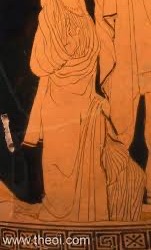
The explanation of the myth
Thus the lovely maiden Persephone became the rightful wife of Hades and Queen of the Underworld. During the six months that Persephone spent in the Underworld, her mother was sad and not in the mood to deal with harvest. Thus she would leave the Earth to decline.
According to the ancient Greeks, these were the months of Autumn and Winter, when the land is not fertile and does not give crops. Whenever Persephone went to Olympus to live with her mother, Demeter would shine from happiness and the land would become fertile again and fruitful. These were the months of Spring and Summer. Therefore, this myth was created to explain the change of the seasons, the eternal cycle of the Nature's death and rebirth.
More info:
Overview
Persephone, often known simply as Kore (“Maiden”), was a daughter of Zeus and Demeter. Her mythology tells of how she was abducted by her uncle Hades one day while picking flowers. Demeter, distraught, wandered the entire world in search of her daughter.
When Demeter at last located Persephone in the Underworld, she demanded that her daughter be returned. But Hades had tricked Persephone into eating something—a handful of pomegranate seeds—while she was in the Underworld. Thus, although Persephone was allowed to spend part of the year on Olympus with her mother, she was forced to spend the other part of the year in the Underworld as Hades’ bride.
As the wife of Hades, Persephone was the queen of the Underworld. She was also associated with spring, girlhood, and marriage. Persephone was often worshipped alongside her mother, Demeter—for example, in the Eleusinian Mysteries.

Etymology
Ancient authors sometimes sought creative etymologies for the name “Persephone” (Greek Περσεφόνη, translit. Persephonē). Plato, for example, interpreted the name as “she who touches things that are in motion” (epaphē tou pheromenou), a reference to Persephone’s wisdom (to touch things that are in motion implies an understanding of the cosmos, which is constantly in motion).[1]
Other ancient etymologies connected Persephone’s name with aphenos (“wealth”), phonos (“death”), and phōs (“light”). But these are folk etymologies that lack credibility.
Nowadays, Persephone’s name is often thought to have Indo-European origins. Robert Beekes and others have connected it to two Indo-European roots: *perso- (“sheaf of corn”) and *-gʷn-t-ih₂ (“hit, strike”). This would indicate that Persephone’s name means something like “female corn thresher.”[2]
Pronunciation
ENGLISH
GREEK
Persephone
Περσεφόνη (translit. Persephonē)
PHONETIC
IPA
[per-SEF-uh-nee]
/pərˈsɛf ə ni/
Alternate Names
The name Kore (Korē, “Maiden”) was commonly used as an alternative to “Persephone” and highlighted the goddess’s role as the daughter of Demeter, goddess of agriculture. Another alternate name, Despoina (“Mistress”), focused on Persephone’s role as the wife of Hades and queen of the Underworld.
There were several alternate forms of the name “Persephone” itself, including Persophatta or Persephatta (which may have been the original form of the name), Persephoneiē (the Homeric form), Pherrephatta, and Phersephonē.
Persephone’s Roman counterpart was called Proserpina or Proserpine.
Titles and Epithets
Persephone was known by numerous cult titles, including Sōteira (“Savior”) and Brimō (“Angry”). She also had a handful of epithets. These included epainē (“awful”), which stressed Persephone’s role as queen of the Underworld, as well as agauē (“venerable”), hagnē (“holy”), and arrētos (“she who must not be named”).
Attributes
There were two sides to Persephone. On the one hand, she was Persephone, wife of Hades and goddess of the Underworld, and thus a chthonic figure closely associated with the inevitability of death. On the other hand, she was Kore, the maiden daughter of the agricultural goddess Demeter, an alternate guise that brought her into the sphere of agriculture and fertility. In her ritual and mythology, Persephone/Kore was also regarded as a goddess of all aspects of womanhood and female initiation, including girlhood, marriage, and childbearing.
True to her double nature, Persephone was imagined as having two homes: one on Olympus with her mother, Demeter, and the other in the Underworld with her husband, Hades. According to Homer, she also possessed sacred groves on the western edge of the world, near the entrance to the Underworld.[3]
In her iconography, Persephone was represented as a young woman, modestly clad in a robe and wearing either a diadem or a cylindrical crown called a polos on her head.
Persephone was characterized by several attributes and symbols, most notably torches, stalks of grain or ears of corn, and scepters. More rarely, she was associated with pomegranates or poppies. Other attributes, such as the rooster, were more localized and tied to the iconography of specific cults.
Locri Pinax Of Persephone And Hades
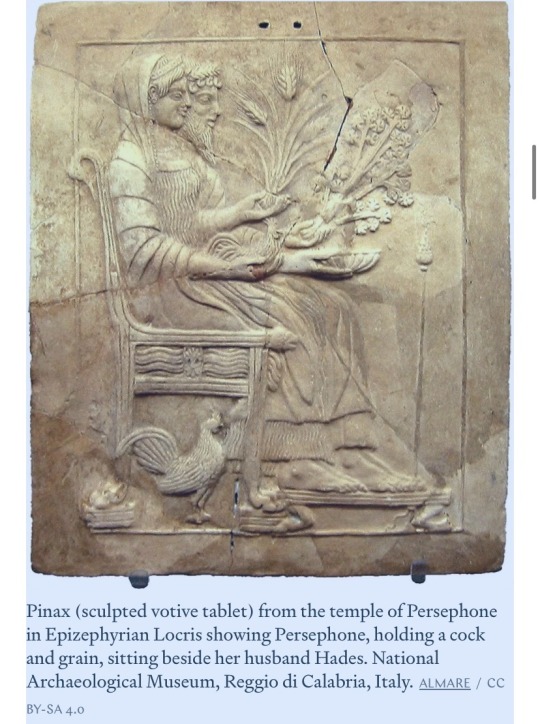
Several scenes from Persephone’s mythology—especially her abduction by Hades—were popular among ancient artists.[4]
Family
In the standard tradition, Persephone was the daughter of Zeus, the king of the gods, and his sister Demeter, the goddess of agriculture.[5] But there were a handful of rival traditions surrounding Persephone’s parentage, including one in which she was the daughter of Zeus and Styx, an Oceanid who gave her name to one of the rivers of the Underworld.[6] The Orphic version of Persephone, on the other hand, was a daughter of Zeus and Rhea,[7] while an Arcadian version of Persephone called Despoina was the daughter of Demeter and Poseidon.[8]
Persephone krater Antikensammlung Berlin 1984.40
The so-called “Persephone Krater,” an Apulian red-figure volute-krater by the Circle of the Darius Painter (ca. 340 BCE). Altes Museum, Berlin, Germany. BIBI ST. PAULPUBLIC DOMAIN
Persephone was usually regarded as the only child born to Zeus and Demeter, but both gods had children with other consorts. Thus, Persephone’s half-siblings included Demeter’s other children (Arion, Corybas, and Plutus) as well as the numerous children of the promiscuous Zeus (including Apollo, Artemis, Athena, Dionysus, Heracles, Perseus—and many, many others).
Family Tree
Parents
FATHER
MOTHER
Zeus
Demeter
Siblings
BROTHERS
SISTERS
Arion
Apollo
Corybas
Dionysus
Heracles (Hercules)
Hephaestus
Ares
Hermes
Perseus
Aphrodite
Artemis
Athena
Consorts
HUSBAND
LOVERS
Hades
Adonis
Zeus
Children
DAUGHTERS
SONS
Erinyes (Furies)
Melinoe
Dionysus
Zagreus
Mythology
Abduction by Hades
Persephone was the daughter of Demeter and Zeus. The most detailed account of her myth comes from the second Homeric Hymn, also known as the Homeric Hymn to Demeter.
This poem describes how Persephone was picking flowers in a meadow when she was abducted—with Zeus’ permission[14]—by Hades, the god of the Underworld and the brother of Demeter and Zeus (and thus Persephone’s uncle).[15] Later sources added that it was Aphrodite and Eros who caused Hades to fall in love with Persephone in the first place.[16]
Rape of Prosepina - Bernini 1621-22
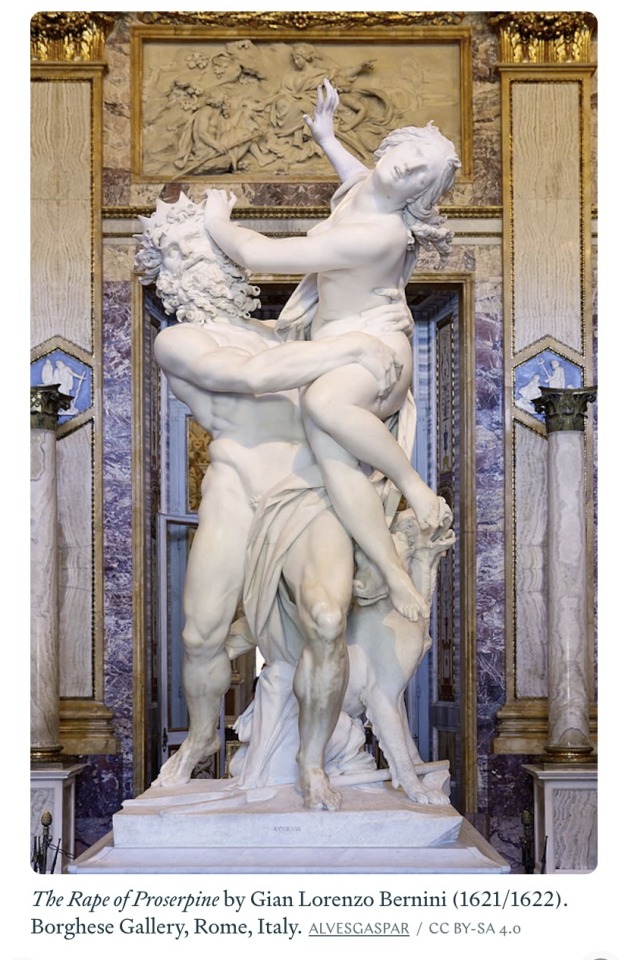
The Homeric Hymn then tells of how Demeter, realizing her daughter was missing, began a desperate search. After wandering the entire earth, Demeter finally learned the truth from Hecate, the goddess of witchcraft, who had happened to hear Persephone cry out before she disappeared.
Though Hecate did not know where Persephone had been taken, she told Demeter to seek information from Helios, the charioteer of the sun, who was the only witness to the crime. Sure enough, Helios was able to tell Demeter how Hades had abducted her daughter.[17]
Upon discovering that Hades had Persephone—and that Zeus himself had helped him kidnap her—Demeter was justifiably furious:
But grief yet more terrible and savage came into the heart of Demeter, and thereafter she was so angered with the dark-clouded Son of Cronos that she avoided the gathering of the gods and high Olympus, and went to the towns and rich fields of men, disfiguring her form a long while.[18]
Eventually, Demeter’s wanderings brought her to Eleusis, a town in the region of Attica, just northwest of Athens. Demeter arrived at the palace disguised as an old woman, where she was treated kindly by Queen Metaneira and King Celeus. In return, she nursed their sick child, known as Demophon in most versions of the myth,[19] and tried to make him immortal.

When Demeter’s efforts to impart immortality failed (the boy’s mother, Metaneira, inadvertently interrupted the process when she saw Demeter holding the child in a fire), Demeter commanded the Eleusinians to build her a temple. She then abandoned her functions as the goddess of agriculture, causing grain to stop growing and nearly starving humanity. Demeter’s terrible rage was ended only through the intervention of Zeus, who sent the messenger god Hermes to persuade Hades to return Persephone to Demeter.
Hades told Hermes he would release Persephone—as long as she had not tasted food while in the Underworld. He then tricked Persephone into eating a handful of pomegranate seeds. Because of this, Persephone could not leave Hades for good. In the end, a compromise was reached: Persephone would spend part of the year in the Underworld as Hades’ wife and the other part on Olympus with her mother, Demeter.[20]
Persephone in the Underworld
Persephone was the queen of the Underworld and so ruled over all mortals who had died. Though dreaded, she did sometimes listen to and grant requests. For example, she allowed the prophet Tiresias to keep his reasoning and prophetic abilities even in death.[21]
Persephone also featured in the myths of a handful of heroes and mortals who descended to and returned from the Underworld. According to one source, she was the one who allowed Orpheus to bring his dead wife Eurydice back from the Underworld, provided he did not look back while leading her up (a condition that Orpheus failed to meet).[22]
In another story, Theseus agreed to help Pirithous abduct Persephone from the Underworld, but they were caught and held prisoner. In some versions, Persephone eventually allowed Heracles to bring Theseus and Pirithous back with him when he came to the Underworld to fetch Cerberus (as part of his final labor).[23]
Persephone also featured in some versions of the myth of Alcestis. When Alcestis’ husband Admetus was told that he could put off his death if he found somebody willing to die in his place, Alcestis bravely volunteered. According to some authors, Persephone was so moved by this deed that she allowed Alcetis to return to the land of the living (in the more familiar version, though, Alcestis was brought back by Heracles).[24]
At least one person tried to take advantage of Persephone’s amenable nature. When Sisyphus wanted to escape death, he came up with a clever trick. He told his wife not to bury him; then, when he arrived in the Underworld, he convinced Persephone (though in some versions it was Hades) to let him return to the world of the living to punish his wife for neglecting his funeral.[25]
Lovers and Rivals in Love
The fact that Persephone was married did not prevent her from being imagined as a virginal maiden. There were, however, a handful of myths that challenged this persona.
According to some sources, Persephone vied with Aphrodite for the love of Adonis, an astonishingly handsome mortal man. Eventually, Zeus determined that Adonis would spend part of the year with Aphrodite and part of the year with Persephone.[26]
terracotta loutrophoros darius painter 340-330 bce
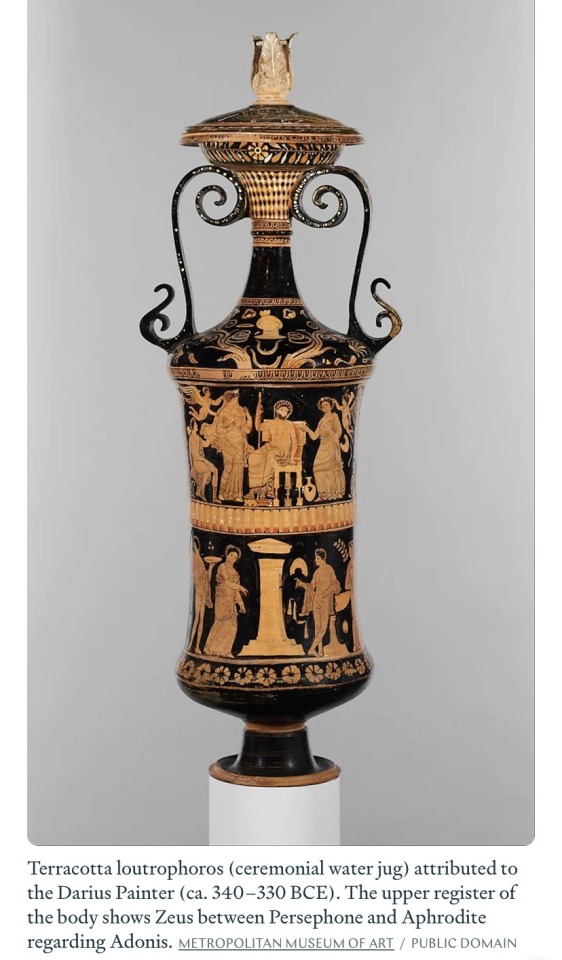
In another myth, Hades took a nymph named Minthe as his lover. When Persephone found out, she jealously trampled Minthe and turned her into a plant: garden mint.[27]
Orphic Mythology
The Orphics, an ancient Greek religious community that subscribed to distinctive beliefs and practices (called “Orphism,” “Orphic religion,” or the “Orphic Mysteries”), had their own unique mythology of Persephone.
According to several strands of Orphism, Persephone was the daughter of Zeus and his mother, the Titan Rhea (rather than Demeter). She was conceived after Zeus transformed himself into a snake to have sex with Rhea. When Persephone was born, she had a monstrous form, with numerous eyes, an animal’s head, and horns. Terrified, Rhea refused to nurse the child and fled. But Zeus transformed into a snake again and had sex with Persephone, whereupon she conceived the god often called Zagreus or Dionysus Zagreus.[28]
Worship
Temples
Persephone had temples throughout the Greek world, many of them shared with Demeter. The most notable of these was the Temple of Demeter in Eleusis, a huge, ancient temple likely built during the seventh century BCE. The famous “Eleusinian Mysteries,” religious rites honoring Demeter and Persephone/Kore, were performed there.
excavation-of-temple-to-demeter-persephone-eleusis-greece

Persephone shared many other temples with Demeter, though she also had several temples of her own; the one at Epizephyrian Locris (a Greek colony in southern Italy) is an important example.[29] At other sites, including Teithras in Attica,[30] Acrae in Sicily,[31] and the island of Thasos,[32] Persephone had a separate sanctuary called a Koreion.
Elsewhere, such as Cyzicus,[33] Erythrae,[34] Sparta,[35] Megalopolis in Arcadia,[36] and the Athenian deme of Corydallus,[37] Persephone was worshipped with the cult title Soteira, meaning “Savior.”
Festivals and Rituals
Just as Persephone shared many of her temples with Demeter, she also shared many of her festivals with her.
The most important festival of Persephone and Demeter, the Thesmophoria, was celebrated by married women throughout the ancient Greek world. In Athens, the Thesmophoria lasted three days and involved several rituals, including one in which the rotten remains of a slaughtered pig were dug up and placed on the altars of the goddesses.[38] The Thesmophoria was also celebrated in other parts of Greece, such as the region of Boeotia.[39]
Many of the festivals of Persephone and Demeter were related to the myth of Persephone’s abduction. At Eleusis, worshippers reenacted Demeter’s search for Persephone at night by torchlight. When Persephone was “found,” the ritual ended with celebration, torch throwing, and probably the sounding of a gong.[40] At Megara, similarly, worshippers reenacted Persephone’s abduction by a sacred rock called Anaklēthris, where Demeter was believed to have “called back” (anekalesen in Greek) Persephone when she passed by it during her search.[41]
In Sicily, sometimes said to have been the island from which Hades had abducted the goddess, Persephone was honored in a number of different festivals and rituals. The Korēs Katagōgē (“Descent of Kore”), for example, commemorated Hades taking Persephone (Kore) down to the Underworld.[42] Every year in the Sicilian city of Syracuse, Persephone was honored with the sacrifices of smaller animals and the public drowning of bulls.[43]
Another festival, called the Chthonia, was celebrated annually at Hermione, a city in the Argolid. It honored Demeter in her connection with Persephone, the queen of the Underworld. One part of the festival involved four old women who sacrificed four heifers with sickles.[44]
Other festivals celebrated Persephone in connection with the institution of marriage (rather than with Demeter and agriculture). This seems to have been how Persephone was honored at her temple in Epizephyrian Locris. In some Sicilian cities[45] and in the Locrian colony of Hipponion,[46] there were festivals celebrating Persephone’s wedding.
In Cyzicus, where Persephone was worshipped under the title Soteira, her festival was called either the Soteria,[47] the Pherephattia,[48] or the Koreia.[49] A festival called the Koreia appears to have also been celebrated in Arcadia[50] and Syracuse[51] (though the Syracusean Koreia was likely simply the equivalent of the Thesmophoria).
Persephone, both individually and together with other gods, was also honored through festival and ritual at numerous other sites, including Mantinea, Argos, Patrae, Smyrna, and Acharaca.
Other Worship: Orphism and Curse Tablets
The Orphics, who called Persephone either Despoina[52] or the “Chthonian Queen,”[53] worshipped her primarily in connection with the Underworld. They also associated her with salvation: it was believed that she would grant a blissful afterlife to those who had been properly purified.
Persephone was often invoked on curse tablets under her Underworld title Despoina. Curse tablets were engraved texts that called upon a god, usually a “chthonian” god associated with the Underworld (such as Hecate, Hermes, or Gaia), to punish or harm an enemy, who would generally be named in the text.
Pop Culture
Persephone has continued to captivate the modern imagination as the virginal yet terrifying queen of the Underworld. She has appeared in a handful of modern adaptations of Greek mythology, including Rick Riordan’s Percy Jackson and the Olympians franchise, the 1990s TV series Hercules: The Legendary Journeys, and even the video game Assassin’s Creed: Odyssey.
Together with Demeter, Persephone is also depicted on the Great Seal of North Carolina, where she is shown in a pastoral setting with the sea in the background.

I hope you enjoyed this blog more to following soon,
Culture Calypso’s Blog 🌹💀🔥🩸🌺🥀
#my blogs#spirituality#history#religion#paganism#greek mythology#roman mythology#persephone#proserpina#goddesses#underworld#deities#SoundCloud
2 notes
·
View notes
Text
🌾 Today’s blog is on Demeter :: Greek Goddess of Agriculture 🌾 check out my Demeter boxset in my shop @ facebook.com/thehealingcabinmichigan I’ll be doing several Goddess inspired box sets get yours today!
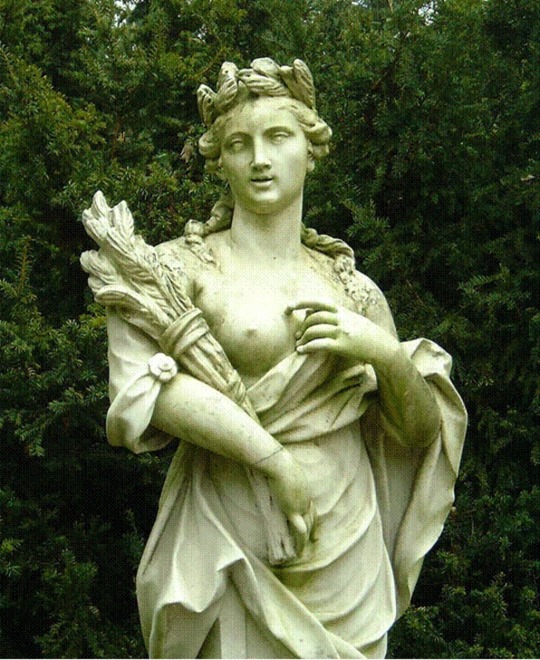
Demeter, the middle daughter of Cronus and Rhea, was the Ancient Greek goddess of grain and agriculture, one of the original Twelve Olympians. Her grief over her daughter Persephone – who has to spend one-third of the year with her husband Hades in the Underworld – is the reason why there is winter; her joy when she gets her back coincides with the fertile spring and summer months. Demeter and Persephone were the central figures of the Eleusinian Mysteries, the most famous secret religious festival in Ancient Greece.
Demeter’s Role
Demeter's Name
Demeter’s name consists of two parts, the second of which (-meter) is almost invariably linked with the meaning “mother,” which conveniently fits with Demeter’s role as a mother-goddess. However, there are still debates over the meaning of the first part (De-), which most scholars associate with “Ge,” i.e., Gaea (making Demeter “Mother Earth”); others, however, prefer to link it with “Deo,” which is a surviving epithet of Demeter and may have been, in an earlier form, the name of one of few grains.
Demeter's Portrayal and Symbolism
Demeter is usually portrayed as a fully-clothed and matronly-looking woman, either enthroned and regally seated or proudly standing with an extended hand. Sometimes she is depicted riding a chariot containing her daughter Persephone, who is almost always in her vicinity. The goddesses – as they were endearingly called – even share the same attributes and symbols: scepter, cornucopia, ears of corn, a sheaf of wheat, torch, and occasionally, a crown of flowers.
Demeter's Epithets
Demeter was known mostly as the Giver of Food and Grain, or “She of the Grain,” for short (Sito). However, since she presided over something as vital as the cycles of plants and seasons, the Ancient Greeks also referred to her as Tesmophoros, or “The Bringer of Laws,” and organized a women-only festival called Tesmophoria to celebrate her as such. Other epithets include: “Green,” “The Giver of Gifts,” “The Bearer of Food,” and “Great Mother.”

Who were Zeus’ Lovers?
How was the World created?
What is the Trojan Horse?
Demeter's Family
Demeter was one of the six children of Cronus and Rhea, their middle daughter, and their second child overall – born after Hestia, but before Hera and her brothers: Hades, Poseidon, and Zeus. Just like all of her siblings, she was swallowed and later, following an intervention by Zeus, regurgitated by her father.
Demeter’s Consorts: Iasion, Poseidon, and Zeus
Demeter didn’t have many partners and was rarely portrayed with a male consort. The mortal Iasion and her brothers Poseidon and Zeus are the most noteworthy – if not the only – exceptions.
Demeter and Iasion
Early in her life, Demeter fell in love with a mortal named Iasion. She seduced him at the marriage of Cadmus and Harmonia and lay with him in a thrice-plowed field. Zeus didn’t think appropriate for such a respected goddess to have a relationship with a mortal, so he struck Iasion with a thunderbolt. But, by then, Demeter was already pregnant with twins: Ploutos and Philomelus, the former the god of wealth, and the latter, the patron of plowing.
Demeter and Poseidon
Next, Demeter’s brother Poseidon forced himself upon her (once transformed into a stallion), and the goddess, once again, became pregnant with two children: Despoena, a nymph, and Arion, a talking horse.
Demeter and Zeus
Finally, Demeter became Zeus’ fourth wife. From their union, Demeter’s most well-known child was born, Persephone.
Demeter and Persephone
The most important myth involving Demeter concerns her daughter Persephone’s abduction by Hades and Demeter’s subsequent wanderings.
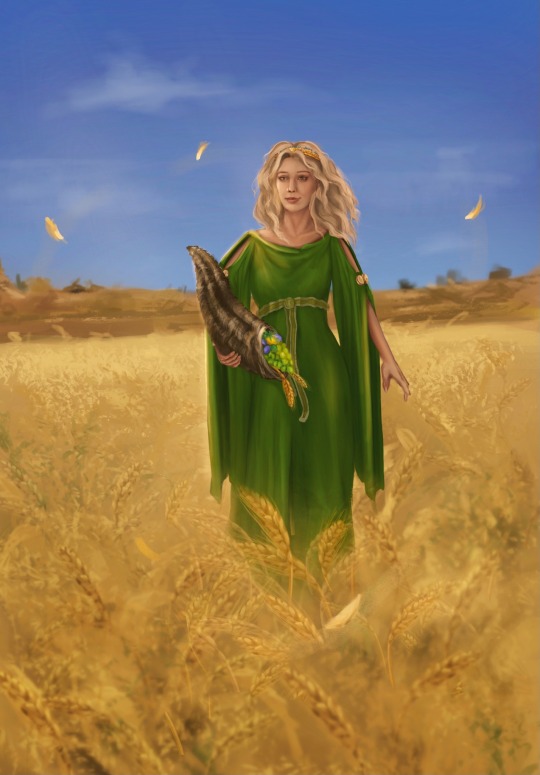
The Abduction of Persephone
Hades, the Lord of the Underworld, fell in love with Demeter’s virgin-daughter and decided to take her into marriage. So, one day, as she was gathering flowers with her girlfriends, he lured her aside using a fragrant and inexpressibly beautiful narcissus, and then snatched her up with his chariot, suddenly darting out of a chasm under her feet.
Demeter Finds Out
Inconsolable, Demeter walked the earth far and wide for nine days to find her daughter – but to no avail. And then, on the tenth day, Hecate told her what she had seen and Helios, the All-Seeing God of the Sun, confirmed her story. Demeter wasn’t just brokenhearted anymore. She was now angry as well. And with everybody! Especially with Zeus who, the rumors claimed so, had approved the whole operation and even aided Hades throughout.

The Institution of the Eleusinian Mysteries · Iambe, Demophon, and Metanira
So, Demeter left Mount Olympus and went to grieve her daughter among the mortals, disguised as an old woman. She ended up at the court of King Celeus of Eleusis, where his wife Metanira hired her to be the nurse to her baby son, Demophon. Iambe, the old servant woman of the house, cheered her with her jokes, and Demeter laughed for the first time in many weeks. In gratitude for the kindness, Demeter devised a plan to make Demophon immortal, so she started bathing him in fire each night, thus, burning away his mortality.
However, one day, Metanira witnessed the ritual and, not realizing what was happening, started screaming in panic and alarm. This disturbed Demeter’s strategy, so she revealed herself at once and told Metanira that the only way that the Eleusinians will ever win her kindness back is by building a temple and establishing a festival in her glory.
The Return of Persephone and the Establishment of the Cycles

King Celeus did just that, and Demeter spent a whole year living in her newly built temple, grieving, and, in her grief, neglecting all her duties as a goddess of fertility and agriculture. As a consequence, the earth turned barren, and people started dying out of hunger. After unsuccessfully sending all the gods, one by one, to Demeter with gifts and pleas, Zeus realized that he would have to bring Persephone back to her mother if he didn’t want to see humanity wiped out from the planet.
So, he sent Hermes to Hades, and the divine messenger fetched back Persephone to her mother. However, the gods soon realized that Demeter’s daughter had already eaten one seed of pomegranate in the Underworld, which obliged her to remain in the Underworld. Knowing that Demeter wouldn’t allow such thing to happen, Zeus proposed a compromise: Persephone would spend one-third of the year with Hades and the other two-thirds with Demeter.
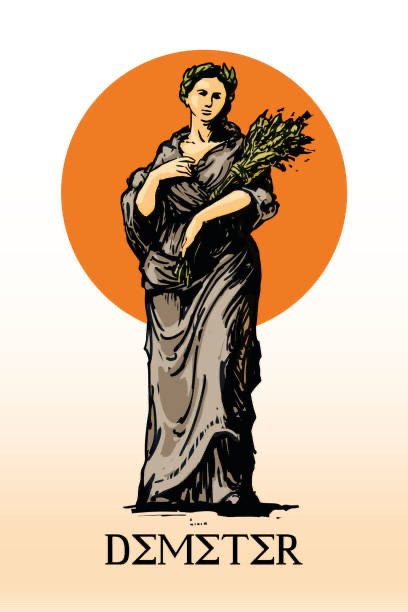
The former, the period during which Demeter is grieving, corresponds to the winter months of the year when the earth is infertile and bare; the latter, when she rejoices, overlaps with the abundant months of our springs and summers. The myth likewise explains the growth cycle of the plants. The grain, just like Persephone, must die and be buried under the earth in order to bear much fruit above it.
I hope you enjoyed this blog more to follow soon
Culture Calypso’s Blog 🌾
#my blogs#spirituality#history#religion#paganism#greek mythology#smallbuisnessowner#demeter#agriculture#harvestseason
6 notes
·
View notes
Text
Today's blog is on the pagan holiday Beltane on 5-1-21 BLESSED BELTANE!
🌳👑🌿🔥🙌🍄🌖🌌🌼🦋🌻🌸💐



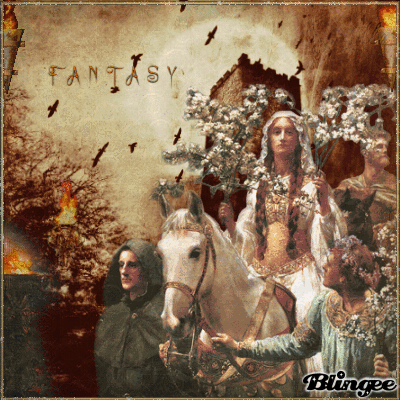



Beltane
Beltane or Beltain (/ˈbɛl.teɪn/) is the Gaelic May Day festival. Most commonly it is held on 1 May, or about halfway between the spring equinox and summer solstice. Historically, it was widely observed throughout Ireland, Scotland, and the Isle of Man. In Irish the name for the festival day is Lá Bealtaine ([l̪ˠaː ˈbʲal̪ˠt̪ˠənʲə]), in Scottish Gaelic Là Bealltainn ([l̪ˠaː ˈpjaul̪ˠt̪ɪɲ]) and in Manx Gaelic Laa Boaltinn/Boaldyn. It is one of the four Gaelic seasonal festivals—along with Samhain, Imbolc and Lughnasadh—and is similar to the Welsh Calan Mai.
Also calledLá Bealtaine (Irish)
Là Bealltainn (Scottish Gaelic)
Laa Boaltinn/Boaldyn (Manx)[1]
Beltaine (French)
Beltain; Beltine; Beltany[2][3]Observed byHistorically: Gaels
Today: Irish people, Scottish people, Manx people, Galician people, Wiccans, and Celtic neopagansTypeCultural
Pagan (Celtic polytheism, Celtic neopaganism, Wicca)SignificanceBeginning of summerCelebrationslighting bonfires, decorating homes with May flowers, making May bushes, visiting holy wells, feastingDate1 May[4]
(or 1 November in the S. Hemisphere)FrequencyannualRelated toMay Day, Calan Mai, Walpurgis Night
Beltane is mentioned in some of the earliest Irish literature and is associated with important events in Irish mythology. Also known as Cétshamhain ("first of summer"), it marked the beginning of summer and it was when cattle were driven out to the summer pastures. Rituals were performed to protect the cattle, crops and people, and to encourage growth. Special bonfires were kindled, and their flames, smoke and ashes were deemed to have protective powers. The people and their cattle would walk around or between bonfires, and sometimes leap over the flames or embers. All household fires would be doused and then re-lit from the Beltane bonfire. These gatherings would be accompanied by a feast, and some of the food and drink would be offered to the aos sí. Doors, windows, byres and livestock would be decorated with yellow May flowers, perhaps because they evoked fire. In parts of Ireland, people would make a May Bush: typically a thorn bush or branch decorated with flowers, ribbons, bright shells and rushlights. Holy wells were also visited, while Beltane dew was thought to bring beauty and maintain youthfulness. Many of these customs were part of May Day or Midsummer festivals in other parts of Great Britain and Europe.
Beltane celebrations had largely died out by the mid-20th century, although some of its customs continued and in some places it has been revived as a cultural event. Since the late 20th century, Celtic neopagans and Wiccans have observed Beltane or a related festival as a religious holiday. Neopagans in the Southern Hemisphere celebrate Beltane on or around 1 November.
Historic Beltane customs
Beltane was one of four Gaelic seasonal festivals: Samhain (~1 November), Imbolc (~1 February), Beltane (~1 May), and Lughnasadh (~1 August). Beltane marked the beginning of the pastoral summer season, when livestock were driven out to the summer pastures. Rituals were held at that time to protect them from harm, both natural and supernatural, and this mainly involved the "symbolic use of fire". There were also rituals to protect crops, dairy products and people, and to encourage growth. The aos sí (often referred to as spirits or fairies) were thought to be especially active at Beltane (as at Samhain) and the goal of many Beltane rituals was to appease them. Most scholars see the aos sí as remnants of the pagan gods and nature spirits. Beltane was a "spring time festival of optimism" during which "fertility ritual again was important, perhaps connecting with the waxing power of the sun".
Before the modern era
Beltane (the beginning of summer) and Samhain (the beginning of winter) are thought to have been the most important of the four Gaelic festivals. Sir James George Frazer wrote in The Golden Bough: A Study in Magic and Religion that the times of Beltane and Samhain are of little importance to European crop-growers, but of great importance to herdsmen. Thus, he suggests that halving the year at 1 May and 1 November dates from a time when the Celts were mainly a pastoral people, dependent on their herds.
The earliest mention of Beltane is in Old Irish literature from Gaelic Ireland. According to the early medieval texts Sanas Cormaic (written by Cormac mac Cuilennáin) and Tochmarc Emire, Beltane was held on 1 May and marked the beginning of summer. The texts say that, to protect cattle from disease, the druids would make two fires "with great incantations" and drive the cattle between them.
According to 17th-century historian Geoffrey Keating, there was a great gathering at the hill of Uisneach each Beltane in medieval Ireland, where a sacrifice was made to a god named Beil. Keating wrote that two bonfires would be lit in every district of Ireland, and cattle would be driven between them to protect them from disease. There is no reference to such a gathering in the annals, but the medieval Dindsenchas includes a tale of a hero lighting a holy fire on Uisneach that blazed for seven years. Ronald Hutton writes that this may "preserve a tradition of Beltane ceremonies there", but adds "Keating or his source may simply have conflated this legend with the information in Sanas Chormaic to produce a piece of pseudo-history. Nevertheless, excavations at Uisneach in the 20th century found evidence of large fires and charred bones, showing it to have been ritually significant.
Beltane is also mentioned in medieval Scottish literature. An early reference is found in the poem 'Peblis to the Play', contained in the Maitland Manuscripts of 15th- and 16th-century Scots poetry, which describes the celebration in the town of Peebles.
Modern era
From the late 18th century to the mid 20th century, many accounts of Beltane customs were recorded by folklorists and other writers. For example John Jamieson, in his Etymological Dictionary of the Scottish Language (1808) describes some of the Beltane customs which persisted in the 18th and early 19th centuries in parts of Scotland, which he noted were beginning to die out. In the 19th century, folklorist Alexander Carmichael (1832–1912), collected the Gaellic song Am Beannachadh Bealltain (The Beltane Blessing) in his Carmina Gadelica, which he heard from a crofter in South Uist. The first two verses were sung as follows:
Beannaich, a Thrianailt fhioir nach gann, (Bless, O Threefold true and bountiful,)
Mi fein, mo cheile agus mo chlann, (Myself, my spouse and my children,)
Mo chlann mhaoth's am mathair chaomh 'n an ceann, (My tender children and their beloved mother at their head,)
Air chlar chubhr nan raon, air airidh chaon nam beann, (On the fragrant plain, at the gay mountain sheiling,)
Air chlar chubhr nan raon, air airidh chaon nam beam. (On the fragrant plain, at the gay mountain sheiling.)
Gach ni na m' fhardaich, no ta 'na m' shealbh, (Everything within my dwelling or in my possession,)
Gach buar is barr, gach tan is tealbh, (All kine and crops, all flocks and corn,)
Bho Oidhche Shamhna chon Oidhche Bheallt, (From Hallow Eve to Beltane Eve,)
Piseach maith, agus beannachd mallt, (With goodly progress and gentle blessing,)
Bho mhuir, gu muir, agus bun gach allt, (From sea to sea, and every river mouth,)
Bho thonn gu tonn, agus bonn gach steallt. (From wave to wave, and base of waterfall.)[18]
Bonfires
A Beltane bonfire at Butser Ancient Farm
Bonfires continued to be a key part of the festival in the modern era. All hearth fires and candles would be doused before the bonfire was lit, generally on a mountain or hill. Ronald Hutton writes that "To increase the potency of the holy flames, in Britain at least they were often kindled by the most primitive of all means, of friction between wood." In the 19th century, for example, John Ramsay described Scottish Highlanders kindling a need-fire or force-fire at Beltane. Such a fire was deemed sacred. In the 19th century, the ritual of driving cattle between two fires—as described in Sanas Cormaic almost 1000 years before—was still practised across most of Ireland and in parts of Scotland. Sometimes the cattle would be driven "around" a bonfire or be made to leap over flames or embers. The people themselves would do likewise. In the Isle of Man, people ensured that the smoke blew over them and their cattle. When the bonfire had died down, people would daub themselves with its ashes and sprinkle it over their crops and livestock. Burning torches from the bonfire would be taken home, where they would be carried around the house or boundary of the farmstead and would be used to re-light the hearth. From these rituals, it is clear that the fire was seen as having protective powers. Similar rituals were part of May Day, Midsummer or Easter customs in other parts of the British Isles and mainland Europe. According to Frazer, the fire rituals are a kind of imitative or sympathetic magic. According to one theory, they were meant to mimic the Sun and to "ensure a needful supply of sunshine for men, animals, and plants". According to another, they were meant to symbolically "burn up and destroy all harmful influences".
Food was also cooked at the bonfire and there were rituals involving it. Alexander Carmichael wrote that there was a feast featuring lamb, and that formerly this lamb was sacrificed. In 1769, Thomas Pennant wrote that, in Perthshire, a caudle made from eggs, butter, oatmeal and milk was cooked on the bonfire. Some of the mixture was poured on the ground as a libation. Everyone present would then take an oatmeal cake, called the bannoch Bealltainn or "Beltane bannock". A bit of it was offered to the spirits to protect their livestock (one bit to protect the horses, one bit to protect the sheep, and so forth) and a bit was offered to each of the animals that might harm their livestock (one to the fox, one to the eagle, and so forth). Afterwards, they would drink the caudle.
According to 18th century writers, in parts of Scotland there was another ritual involving the oatmeal cake. The cake would be cut and one of the slices marked with charcoal. The slices would then be put in a bonnet and everyone would take one out while blindfolded. According to one writer, whoever got the marked piece would have to leap through the fire three times. According to another, those present would pretend to throw them into the fire and, for some time afterwards, they would speak of them as if they were dead. This "may embody a memory of actual human sacrifice", or it may have always been symbolic. A similar ritual (i.e. of pretending to burn someone in the fire) was practised at spring and summer bonfire festivals in other parts of Europe.
Flowers and May Bushes
A flowering hawthorn
Yellow flowers such as primrose, rowan, hawthorn, gorse, hazel, and marsh marigold were placed at doorways and windows in 19th century Ireland, Scotland and Mann. Sometimes loose flowers were strewn at the doors and windows and sometimes they were made into bouquets, garlands or crosses and fastened to them. They would also be fastened to cows and equipment for milking and butter making. It is likely that such flowers were used because they evoked fire. Similar May Day customs are found across Europe.
The May Bush and May Bough was popular in parts of Ireland until the late 19th century. This was a small tree or branch—typically hawthorn, rowan, holly or sycamore—decorated with bright flowers, ribbons, painted shells, and so forth. The tree would either be decorated where it stood, or branches would be decorated and placed inside or outside the house. It may also be decorated with candles or rushlights. Sometimes a May Bush would be paraded through the town. In parts of southern Ireland, gold and silver hurling balls known as May Balls would be hung on these May Bushes and handed out to children or given to the winners of a hurling match. In Dublin and Belfast, May Bushes were brought into town from the countryside and decorated by the whole neighbourhood. Each neighbourhood vied for the most handsome tree and, sometimes, residents of one would try to steal the May Bush of another. This led to the May Bush being outlawed in Victorian times. In some places, it was customary to dance around the May Bush, and at the end of the festivities it may be burnt in the bonfire.
Thorn trees were seen as special trees and were associated with the aos sí. The custom of decorating a May Bush or May Tree was found in many parts of Europe. Frazer believes that such customs are a relic of tree worship and writes: "The intention of these customs is to bring home to the village, and to each house, the blessings which the tree-spirit has in its power to bestow."Emyr Estyn Evans suggests that the May Bush custom may have come to Ireland from England, because it seemed to be found in areas with strong English influence and because the Irish saw it as unlucky to damage certain thorn trees. However, "lucky" and "unlucky" trees varied by region, and it has been suggested that Beltane was the only time when cutting thorn trees was allowed. The practice of bedecking a May Bush with flowers, ribbons, garlands and bright shells is found among the Gaelic diaspora, most notably in Newfoundland, and in some Easter traditions on the East Coast of the United States.
Other customs
Holy wells were often visited at Beltane, and at the other Gaelic festivals of Imbolc and Lughnasadh. Visitors to holy wells would pray for health while walking sunwise (moving from east to west) around the well. They would then leave offerings; typically coins or clooties (see clootie well). The first water drawn from a well on Beltane was seen as being especially potent, as was Beltane morning dew. At dawn on Beltane, maidens would roll in the dew or wash their faces with it. It would also be collected in a jar, left in the sunlight, and then filtered. The dew was thought to increase sexual attractiveness, maintain youthfulness, and help with skin ailments.
People also took steps specifically to ward-off or appease the aos sí. Food was left or milk poured at the doorstep or places associated with the aos sí, such as 'fairy trees', as an offering. In Ireland, cattle would be brought to 'fairy forts', where a small amount of their blood would be collected. The owners would then pour it into the earth with prayers for the herd's safety. Sometimes the blood would be left to dry and then be burnt. It was thought that dairy products were especially at risk from harmful spirits. To protect farm produce and encourage fertility, farmers would lead a procession around the boundaries of their farm. They would "carry with them seeds of grain, implements of husbandry, the first well water, and the herb vervain (or rowan as a substitute). The procession generally stopped at the four cardinal points of the compass, beginning in the east, and rituals were performed in each of the four directions".
The festival persisted widely up until the 1950s, and in some places the celebration of Beltane continues today.
As a festival, Beltane had largely died out by the mid-20th century, although some of its customs continued and in some places it has been revived as a cultural event. In Ireland, Beltane fires were common until the mid 20th century, but the custom seems to have lasted to the present day only in County Limerick (especially in Limerick itself) and in Arklow, County Wicklow. However, the custom has been revived in some parts of the country. Some cultural groups have sought to revive the custom at Uisneach and perhaps at the Hill of Tara. The lighting of a community Beltane fire from which each hearth fire is then relit is observed today in some parts of the Gaelic diaspora, though in most of these cases it is a cultural revival rather than an unbroken survival of the ancient tradition. In some areas of Newfoundland, the custom of decorating the May Bush is also still extant. The town of Peebles in the Scottish Borders holds a traditional week-long Beltane Fair every year in June, when a local girl is crowned Beltane Queen on the steps of the parish church. Like other Borders festivals, it incorporates a Common Riding.
Since 1988, a Beltane Fire Festival has been held every year during the night of 30 April on Calton Hill in Edinburgh, Scotland. While inspired by traditional Beltane, this festival is a modern arts and cultural event which incorporates myth and drama from a variety of world cultures and diverse literary sources. Two central figures of the Bel Fire procession and performance are the May Queen and the Green Man.
Neo-Paganism
Beltane and Beltane-based festivals are held by some Neopagans. As there are many kinds of Neopaganism, their Beltane celebrations can be very different despite the shared name. Some try to emulate the historic festival as much as possible. Other Neopagans base their celebrations on many sources, the Gaelic festival being only one of them.
Neopagans usually celebrate Beltane on 30 April – 1 May in the Northern Hemisphere and 31 October – 1 November in the Southern Hemisphere, beginning and ending at sunset. Some Neopagans celebrate it at the astronomical midpoint between the spring equinox and summer solstice (or the full moon nearest this point). In the Northern Hemisphere, this midpoint is when the ecliptic longitude of the Sun reaches 45 degrees.
Celtic Reconstructionist
Celtic Reconstructionists strive to reconstruct the pre-Christian religions of the Celts. Their religious practices are based on research and historical accounts, but may be modified slightly to suit modern life. They avoid modern syncretism and eclecticism (i.e. combining practises from unrelated cultures).
Celtic Reconstructionists usually celebrate Lá Bealtaine when the local hawthorn trees are in bloom. Many observe the traditional bonfire rites, to whatever extent this is feasible where they live. This may involve passing themselves and their pets or livestock between two bonfires, and bringing home a candle lit from the bonfire. If they are unable to make a bonfire or attend a bonfire ceremony, torches or candles may be used instead. They may decorate their homes with a May Bush, branches from blooming thorn trees, or equal-armed rowan crosses. Holy wells may be visited and offerings made to the spirits or deities of the wells. Traditional festival foods may also be prepared.
Wicca
Wiccans use the name Beltane or Beltain for their May Day celebrations. It is one of the yearly Sabbats of the Wheel of the Year, following Ostara and preceding Midsummer. Unlike Celtic Reconstructionism, Wicca is syncretic and melds practices from many different cultures. In general, the Wiccan Beltane is more akin to the Germanic/English May Day festival, both in its significance (focusing on fertility) and its rituals (such as maypole dancing). Some Wiccans enact a ritual union of the May Lord and May Lady.
Name
In Irish, the festival is usually called Lá Bealtaine ('day of Beltane') while the month of May is Mí Bhealtaine ("month of Beltane"). In Scottish Gaelic, the festival is Latha Bealltainn and the month is An Cèitean or a' Mhàigh. Sometimes the older Scottish Gaelic spelling Bealltuinn is used. The word Céitean comes from Cétshamain ('first of summer'), an old alternative name for the festival. The term Latha Buidhe Bealltainn (Scottish) or Lá Buidhe Bealtaine (Irish), 'the bright or yellow day of Beltane', means the first of May. In Ireland it is referred to in a common folk tale as Luan Lae Bealtaine; the first day of the week (Monday/Luan) is added to emphasise the first day of summer.
The name is anglicized as Beltane, Beltain, Beltaine, Beltine and Beltany.
Etymology
Two modern etymologies have been proposed. Beltaine could derive from a Common Celtic *belo-te(p)niâ, meaning 'bright fire'. The element *belo- might be cognate with the English word bale (as in bale-fire) meaning 'white' or 'shining'; compare Old English bǣl, and Lithuanian/Latvian baltas/balts, found in the name of the Baltic; in Slavic languages byelo or beloye also means 'white', as in Беларусь ('White Rus′' or Belarus) or Бе́лое мо́ре ('White Sea').[citation needed] Alternatively, Beltaine might stem from a Common Celtic form reconstructed as *Beltiniyā, which would be cognate with the name of the Lithuanian goddess of death Giltinė, both from an earlier *gʷel-tiōn-, formed with the Proto-Indo-European root *gʷelH- ('suffering, death'). The absence of syncope (Irish sound laws rather predict a **Beltne form) is explained by the popular belief that Beltaine was a compound of the word for 'fire', tene.
In Ó Duinnín's Irish dictionary (1904), Beltane is referred to as Céadamh(ain) which it explains is short for Céad-shamh(ain) meaning 'first (of) summer'. The dictionary also states that Dia Céadamhan is May Day and Mí Céadamhan is the month of May.
There are a number of place names in Ireland containing the word Bealtaine, indicating places where Bealtaine festivities were once held. It is often anglicised as Beltany. There are three Beltanys in County Donegal, including the Beltany stone circle, and two in County Tyrone. In County Armagh there is a place called Tamnaghvelton/Tamhnach Bhealtaine ('the Beltane field'). Lisbalting/Lios Bealtaine ('the Beltane ringfort') is in County Tipperary, while Glasheennabaultina/Glaisín na Bealtaine ('the Beltane stream') is the name of a stream joining the River Galey in County Limerick.
Source: Wikipedia
I hope you've enjoyed this blog more to follow soon,
Blessed be,
Culture Calypso's Blog 🌻🌸💐
20 notes
·
View notes
Text

Today’s Recipes Of Skyrim Blog is…
Sunlight Soufflé!
🪺🌅🪺🌅🪺🌅🪺🌅🪺🌅🪺🌅🪺🌅🪺🌅🪺🌅
The gourmet is known for the finicky instructions he provides in Uncommon Taste, but this Breton dish is actually simple enough to make, even if you don’t have a hickory wood spoon. The result is a light, fluffy meal of egg & cheese with an exquisite flavor that can easily be tweaked and embellished to your own tastes.

Prep: 20 minutes
Cooking: 20 minutes
Makes: 4 servings
Pairs well with: fresh fruit, toast, coffee or tea
Ingredients:
4 eggs separated into yolks and whites
2 tablespoons unsalted butter
2 tablespoons all purpose flour
3/4 cup warm milk
2 1/2 ounces grated Parmesan cheese (about 3/4 cups)
1/2 teaspoon nutmeg
Salt & pepper
Directions:
1. Preheat oven to 375° and lightly butter four 6-inch ramekins.
2. In a medium bowl, beat the egg whites until they form soft peaks then set aside.
3. In a small sauté pan or skillet, melt the butter over medium heat, then stir to make a roux. Cook for a minute or so until all the flour is incorporated, then gradually add in the milk while stirring. Stir for a few more minutes until the whole mixture has thickened. Remove from heat and stir in cheese, nutmeg and a dash of salt & pepper.
4. In a large bowl, beat the egg yolks for 1 minute, until they are pale & creamy. While still beating, gradually add the cheesy roux from the sauté pan & mix throughly. Gently fold in the egg whites, then divide the mixture evenly between the prepared ramekins.
5. Bake for 20-25 minutes, or until puffed & lightly brown on top. Don’t be tempted to open door for a peek! It can cause the soufflés to collapse. Serve immediately and behold, the brilliance of the sun!

I hope you enjoyed this blog this is the last in this series new series soon!
Culture Calypso’s Blog 🌅🪺🌅
13 notes
·
View notes
Text
Reblogged by Shane Lehane Sheelah take a bow: St Patrick’s wife? Probably not – she was far more important than that
A symbol of Irish womanhood, she deserves to be celebrated again every March 18th

The 16th, 17th (St Patrick’s Day) and 18th March: Erskine Nicol’s painting of the Irish celebration that included Sheelah’s Day. Photograph courtesy of the National Gallery of Ireland
Shane Lehane
Fri Mar 15 2019 - 06:00
For hundreds of years Ireland has had an icon of womanhood and a compelling symbol of all things female, yet few people know her name. The forgotten goddess is none other than Sheelah, once widely celebrated on March 18th, both in Ireland and among the diaspora, yet now all but disappeared. Fáilte Ireland should start to champion her alongside St Patrick: she could be worth a fortune.
Two years ago my research into this disregarded deity resulted in somewhat misleading headlines that said Sheelah was St Patrick's wife. That was not the case, but at least it brought Sheelah and her festival back to our attention. I believe Sheelah – or Sheila, Sheela, Shela, Sheelagh or Síle, depending on the source – has far more to her than the once widely held belief that she was our national saint's other half.
Sheelah's Day fell each year on March 18th, and the usual dispensation to disregard Lenten abstinence on March 17th and wet the shamrock – drink alcohol, in other words – in honour of St Patrick was extended to the following day as well, in honour of his so-called wife. The Freeman's Journal of March 20th, 1841, reported that a woman who appeared in court for drunkenness declared she bought "two small naggin of whiskey… not wishing to break through the old custom of taking a drop on St Sheelah's Day". In contrition to the judge, she vowed: "I here promise that for Patrick's Day or Sheelah's Day, or any other day in the calendar, I'll never stand in your presence again."

Some say Sheelah was 'Patrick's wife', others that she was 'Patrick's mother', while all agree that her 'immortal memory' is to be maintained by potations of whiskey
A painting by Erskine Nicol from 1856, depicting the revelries of such mid-Lenten festivities, is accurately entitled The 16th, 17th (St Patrick’s Day) and 18th March. This elongated name recognises that most Irish festivals, including fairs, pattern days and wakes, took place over three days: the gathering, the feast and the scattering. Sheelah’s Day was the last (but not the least) of the traditional three days of celebration that began on the eve of St Patrick’s Day.
William Hone gives a detailed account of Sheelah’s Day celebrations in Britain in The Every-day Book, from 1827.
“The day after St Patrick’s Day is ‘Sheelah’s day’, or the festival in honour of Sheelah. Its observers are not so anxious to determine who ‘Sheelah’ was, as they are earnest in her celebration. Some say she was ‘Patrick’s wife’, others that she was ‘Patrick’s mother’ while all agree that her ‘immortal memory’ is to be maintained by potations of whiskey. The shamrock worn on St Patrick’s day should be worn also on Sheelah’s day, and on the latter night, be drowned in the last glass. Yet it frequently happens that the shamrock is flooded in the last glass of St Patrick’s day, and another last glass or two or more on the same night, deluges the over-soddened trefoil. This is not ‘quite correct’ but it is endeavoured to be remedied the next morning by the display of fresh shamrock, which is steeped at night in honour of ‘Sheelah’ with equal devotedness.”

This festive time coincides with the vernal equinox, one of the two midpoints of the sun’s annual cycle, in the season of new fertility, when days are poised to outlast nights for the first time since the autumn equinox, the previous September. An emphasis on new life and procreation is manifest in a host of mythological incarnations and folk reflexes at this time of the year. The goddess and holy woman Brigid is celebrated on February 1st; the analogous figure of Gobnait, goddess of fertility and beekeeping, is commemorated on February 11th. These women usher in the new cycle of fertility with ploughing, sowing, the birth of animals, the rising of the sap and the reawakening of nature.
This time of year in the past brought an equal emphasis on human marriage and reproduction, with Shrove Tuesday, immediately before Lent, long being the most popular day in Ireland to be married.
The three-day carnival celebrating Patrick and Sheelah occurs at this key point in the calendar and in the annual cycle of fertility. That Sheelah is firmly situated around the equinox, the seminal pivot of fertility, indicates that she had distinct fertility associations and can be viewed as an equivalent to Brigid and Gobnait.
Patrick is fighting with his wife, now a miserable hag at war with the world. She spitefully brushes the last of the winter snow into the way of the new cycle of work
Sheelah still echoes through Newfoundland, otherwise known as Talamh an Éisc, or Land of the Fish, the most Irish place outside Ireland. An amazing legend on this Canadian island, which many still believe to be true, centres on Sheila na Geira, or Síle Ní Ghadhra, a young Irish princess from Connacht. Sometime in the 1600s, when she was en route to a French convent to finish her education under the care of her abbess aunt, pirates commandeered her ship. One of them, Gilbert Pike, from a well-to-do English family, fell in love with her. They married aboard and then settled down in Mosquito, in southwestern Newfoundland. Here, in time, Sheila na Geira gave birth to a child – according to tradition the first white European child to be born in Newfoundland – so it is said that many there owe their lineage to her. It is also said that every Irishman who visited and settled on Newfoundland paid obeisance to Sheila na Geira, who reportedly lived to 105.

In Ireland, especially from the mid-18th century onwards, Síle Ní Ghadhra was one of the most popular representations of the country, and in the aisling, or dream, poetry of the period she epitomises Ireland in its idyllic state: strongly independent, bountiful and fertile. In this sense Sheila joins the many women sovereignty figures who represent Ireland: Ériu, Fódla, Banba, Aoibheall, Clíodhna, Macha, Mór and Mórrígan, to name a few (and not forgetting the Christianised figures of Brigid and Gobnait).
In keeping with her mother-goddess attributes, the last big snowstorm after St Patrick’s Day is still called Sheila’s brush in Newfoundland. The idea is that Patrick is fighting with his wife, now a miserable hag at war with the world. (The idea that Patrick had a wife called Sheila must have arrived with the Irish of the 18th and 19th centuries.) She spitefully brushes the last of the winter snow into the way of the new cycle of work.
It’s significant that Síle na géag, or Sheila of the brush, is one way to render Sheela-na-gig, the name for the naked old woman who appears, exposing her genitals, in medieval stone carvings. We’ll return to this. As for the Newfoundland Sheila’s brush, sealing fleets would refuse to go back out on the ice until this storm had passed; fishermen continue to do so.

Sheila’s brush: Newfoundland fishermen would wait for the first snowstorm after St Patrick’s Day to pass before going back out to sea. Photograph: NFB/Getty
Sheelah is an enigmatic name. It and all its variant spellings appear only about 500 times in the 1911 census of Ireland. By contrast its English equivalent, Julia, has almost 30,000 entries. Similarly, no Sheilas appeared on the manifests for ships taking women convicts to Australia, even though the name has entered the language there as jocular but mildly pejorative slang for a woman or girlfriend.
That Freeman’s Journal court report from 1841 refers to the defendant as “a half-naked, wretched looking old woman” who was “charged with having been found drunk and incapable in the street”. The headline was “A Sheelah’s Forethought”. This and many other references made “Sheelah” a byword for a bedraggled old woman.
But elderly women also had experience of the world and were custodians of inherited knowledge, playing significant roles in rites of passage in the human life cycle and the cycle of the year. They acted as midwives, corpse washers and professional mourners; they advised on herbalism and vernacular medicine; and they were central to events such as the pattern day. In this respect Sheelah, as the old woman, is strongly resonant of the important Irish folk figure known as the Cailleach.
The Cailleach – the old, wise healer – is a multifaceted personification of the female cosmic agency. Irish mythological, historical and folkloric expressions cast her as the expression of the territorial- and tribal-sovereignty queen and as the life force inherent in nature, nurturing and maternal but also terrifying and destructive.

Sheela-na-gig: the medieval stone carvings show folk deities associated with birth and death. Photograph: Getty
The Cailleach tradition’s deep roots in ideas of birth, fertility and death brings us back to the Sheela-na-gig. Ireland has more than 100 examples of these often-misunderstood medieval stone carvings. The women in them, who are reclining or squatting, often have big ears, long hair, gritted teeth, emaciated ribs and prominent breasts.
They often appear on medieval tower houses, medieval church sites and holy wells. I recently came across one on a round tower in Rattoo, in Co Kerry. For a long time they were seen as representations of the evils of lust or as ways of averting the “evil eye”. But Sheela-na-gigs are more convincing, in line with the Cailleach, as folk deities associated with birth and death. And so Sheelah embodies the cycle of fertility that overarches natural, agricultural and human procreation and death.
That Sheelah was thought of as St Patrick’s wife is a significant folk reflex. The cult of Patrick is firmly based on the pre-Christian deity Lug, or Lugh – as in Lughnasa or Lúnasa, the harvest festival – who represents the male side of the life-giving equation. Lug personifies the ideal man, exemplified in the complex ideology of Irish kingship. It is the union of male and female that allows us to exist.

It should be no surprise, then, that the three-day carnival to celebrate St Patrick, a major Christian icon, at the liminal point of the season of fertility, when human procreation is paramount, should include Sheelah, his consort.
As many of her devotees died in the Famine, and given the influence of the misogynist, patriarchal church, she has all but vanished from Irish life. I, for one, will be raising a glass to her on her feast day.
Shane Lehane teaches archaeology, folklore and history at CSN College of Further Education, in Cork, and lectures in the department of folklore and ethnology at University College Cork. He is always interested to hear about local folk custom and tradition; you can email him at [email protected]
I hope you enjoyed this Reblog more to come soon
Regards,
Culture Calypso’s Blog
#sheelah#Ireland#irish literature#irish history#my blogs#spirituality#holydays#saint patricks day#celtic lore#SoundCloud
2 notes
·
View notes
Text
Ma Kali & Kali Mantra: Meaning, Significance, and Benefits 🪷🪬🧿

Goddess Kali is the divine protector of the earth who is also known as Kalika in Hinduism. But due to the goddess' destructive power, Kali is also known as the Dark Mother. As per mythology, the word Kali comes from the Sanskrit word Kala, which means time. Goddess Kali, therefore, represents time, change, power, creation, preservation and destruction. The word Kali also means “the black one”, the feminine noun of the Sanskrit adjective Kala. As per spiritual texts, Goddess Kali is considered a fierce form of Durga/Parvati and the consort of Lord Shiva. Besides being a destructor of bad powers of the universe, Kali ma is also a great giver to those who do good deeds and worship her with utmost devotion. Hence pleasing Kali ma allows the native a lot of compassion and blessings.
As per mythology, Kali maa is the first of the 10 Mahavidyas or manifestations of the Great Goddess. She is usually portrayed in a form where she dances or stands on her consort God Shiva, who lies calm and prostrated beneath her. Kali Maa is worshipped throughout the country but majorly in the seas of Bengal, Assam, Kashmir, Punjab, Himachal Pradesh, Kerala and Tamil Nadu, along with Nepal and Sri Lanka.
Over the centuries, the Goddess Kali has taken many forms to protect the Dharma and religion and destroy the one who commits sins. Astrologers say that Maa Kalika is the most awakened goddess in Hinduism and has walked the earth in four forms – Dakshina Kali, Shamshan Kali, Mother Kali and Mahakali. All these forms have served different purposes, right from Raksha Slaughter to the healing of the earth and its natives.
Kali Mantra
Story behind the destructive form of Maa Kali
There was a notorious asura named Daruk who had pleased Brahma and thus was rewarded a boon. The boon allowed the asura to cause grief to the Gods and Brahmins. If this wasn't enough, Daruk also started setting his kingdom in heaven. Seeing this, all the Gods reached out to Brahma and Vishnu, where they were told only a lady can kill the evil Daruk.

Hearing this, all the Devtas donned a female form and went to fight Daaruk, only to get defeated by him. Post the failure, the Gods reached the Kailash mountain to share the ordeal with Lord Shiva. After listening to the Gods, Lord Shiva looked at Maa Parvati and said, "hey Kalyani I pray to destroy the evil Daruk and save the world." Listening to this, a part of Mother Parvati entered Lord Shiva.
That part of Bhagwati Mata entered the body of Lord Shiva and due to the poison in the throat of Shiva, Bhagwati Mata turned into a black Goddess. Lord Shiva felt that part inside of him and opened his third eye and appeared as Goddess Kali in a fierce form.
Just like Shiva, Maa Kali had a third eye and a lunar line. The throat had a sign of Karla poison, and she carries a trident. Seeing the fierce form of Mother Kali, Gods and Siddhas started fleeing. With the mere hum of Maa Kali, all the Asura army including Daruk was burnt to ashes. Yet, the fierceness of Kali wasn't over. The mother’s anger began to burn the whole world. To save the world from the wrath, Shiva took the form of a child and appeared in front of Kali.
When mother Kali saw that child Shirupi, she became fascinated by that form. She embraced Shiva and started feeding him with her breasts. Soon, Maa Kali became unconscious due to Shivji drinking the wrath of mother Kali. In order to bring the Goddess into consciousness, Shivji performed Shiva Tandava. When mother Kali came back to her senses, she saw Shiva dancing and joined him, due to which she was also called Yogini.
The two forms of Goddess Kali
In Hinduism, Goddess Kali is mainly portrayed and worshipped in two forms. The first is the four-armed form, and the second is the 10-armed form, which is also known as Mahakali. Both these forms have different meanings attached to them.
Four-armed form
The Indian art portrays the four-armed Kali in black or blue colour. The eyes of Kali are red in colour which depicts rage. Her hair is shown dishevelled, small fangs sometimes protrude out of her mouth and her tongue is lolling. The Goddess wears a skirt made of human arms and a garland which is made of human heads. The four-arm form of kali stands on the calm and prostate Shiva. All her four hands hold a different thing, mainly a sword, a Trishul (trident), a severed head, and a bowl or skull-cup (kapala) catching the blood of the severed head.

In her left hands, Kali holds a sword and a human head. Here, the sword signifies divine knowledge, meanwhile the human head signifies the human ego, which must be slain by divine knowledge in order to attain moksha.
The right hands of Maa Kali holds the Abhaya (fearlessness) and Varada (blessing) mudras, which means her devotees will always be saved as she will guide them during and after life.
The Goddess also dons a garland consisting of human heads, variously enumerated at 108 or 51, which is why she is known as the mother of all the mantras in astrology.
The ten-armed form
The ten-armed form of Kali is her Maha Kali form. In her Maha Kali form, she is depicted as shining like a blue stone. Maha Kali has as many as ten faces, ten feet and three eyes for each head. All her ten hands carry various components, each of which represents the power of one of the Devas or Hindu Gods. This power is depicted in the form of the weapons that Maha Kali carries. The implication is that Mahakali is responsible for the powers that these deities possess and the implication is in line with the interpretation that Mahakali is identical to Brahman.
At times, people also tend to worship the “ek mukhi” or one-headed idol of Maha Kali displayed with ten arms, signifying the same concept.
The power tools of Kali are the Kundalini Shakti (the power of spiritual electricity); the Kriya Shakti, the power to creatively affect the universe; and Iccha Shakti, the power of will that personally compels our physical movements and actions, while in the universe it causes the galaxies to rush away from one another into the cosmic night. The chanting of various mantras helps the native have these energies for themselves.
How to chant the Kali mantras
Goddess Kali represents the colour black, and hence darkness appeals to her. This is how you should chant the Kaali Mantras.
Although Kaali Mantra can be chanted in the morning, hours after sunset are more feasible to recite these mantras.
It is best that you chant the Kaali Mantra on a new moon day (Amavasya). Wear the colour Red during the Maa Kali mantra recitation or Puja as Red is the colour that appeases the Goddess.
Also, if you plan to keep an idol or picture of Goddess Kali while reciting the mantra, you must make sure to keep it on a red cloth.
When reciting the Mantras, offer red flowers, fruits and sweets to Maa Kali. Always sit facing the East or North direction when reciting the Kali mantras.
As soon as you begin the recital, you will feel a certain vibration filling your being with strength and confidence.

Any Kali mantra you pick up, it is advised that you chant the Kaali mantra for 40 days to gain all its benefits.
For better benefits, don't eat non-vegetarian food or avoid eating onion and garlic as well.
Important Kaali Mantra
1. Kali Beej Mantra
Kreem is the Ekakshari beej mantra associated with Goddess Kali. As such, the beej mantra doesn't have a specific meaning, but it represents the vibrations that aid the spiritual and mental state of the mind. Chanting the Kali beej mantra connects the native with the energies of Goddess Kali. These transformational energies help the native in fighting evil forces around and within him. It is said that chanting the Kali beej mantra with utmost devotion grants different things - right from devotional to material - to the native depending upon the quality of his or her mind.
The Kali Beej mantra is:
|| ॐ क्रीं काली ||
Om Krim Kali
Meaning- K stands for full knowledge,
R means she is auspicious,
I mean she bestows booms, and
M means that she gives freedom.
‘Salutation to the Supreme.’
Benefits of chanting the Kali Beej mantra
As per astrologers, the Kali beej mantra chanting protects one from all the evil forces.
Also, chanting the Kali beej mantra with full devotion fulfils all your desires and brings positivity to the environment you reside.
The mantra is also recited to uplift the confidence of the native.
Best time to recite the Kali beej mantra After sunset
Number of times to chant this mantra 108 daily for 40 days
Who can recite the Kali beej mantra? Anyone
Chant this mantra facing East or North direction
2. Kali Mantra
Although Goddess Kali looks frightening, she always tends to listen to her devotees' prayers as she is very fond of them. The prayers are better communicated to the Goddess if the devotee chants the Kali Mantra when praying to Goddess Kali. The Kali mantra mentioned below is said to heal the native of his worries and brings him closer to God. The Kali mantra is simple and transforms the devotee to Pure consciousness to help him make better decisions in life.
The Kali Mantra is:
|| ॐ क्रीं कालिकायै नमः ||
Om Kring Kalikaye Namah
Meaning- This mantra is a sound representation of the Mother.

Benefits of chanting the Kali mantra
As mentioned above, the Kali mantra helps in transforming the devotee into pure consciousness, meaning the chanting helps in making his mind clutter-free.
The chanting of this Kali mantra rewards the native with utmost wisdom and knowledge.
The mantra relives one of all sorts of emotional pain. If you are having a hard time controlling your emotions, this mantra is very useful for you.
The mantra is said to bring the native unmatched courage.
Best time to recite the Kali mantra After sunset
Number of times to chant this mantra 108 daily for 40 days
Who can recite the Kali mantra? Anyone
Chant this mantra facing East or North direction
3. Maha Kali mantra
The Maha Kali mantra is not used much due to its purgative nature. However, the one who properly knows how to use the mantra can benefit from the unmatched courage and strength the mantra recitation promises to deliver. Maha Kali is the great divine form of Maa Kali and bestows the natives with the power to accept things around him and change accordingly. If you chant this mantra on a regular basis, you will end up feeling a thrust of positive vibrations around you, which will prompt you to make things happen for you.
The Maha Kali mantra is:
|| ॐ श्री महा कलिकायै नमः ||
Om Sri Maha Kalikayai Namah
Meaning - I bow my head to the Divine dark goddess Mother, Kali or I salute the Divine Mother, Kali.
Benefits of chanting the Maha Kali mantra
One must appease the Divine Mother by chanting this mantra in her honour in order to obtain her grace.
The Maha Kali mantra acts like a shield that saves anyone against the tough times ahead of him.
Reciting the Maha Kali mantra brings stability to the life, and helps the native better decide what is right and what is wrong for him.
Best time to recite the Maha Kali mantra After sunset
Number of times to chant this mantra 108 daily for 40 days
Who can recite the Maha Kali mantra? Anyone
Chant this mantra facing East or North direction
4. Kalika-Yei Mantra
Some problems in our life are just way too complex. The complexity is such that they keep us on our toes, barring us from enjoying and living life as it is meant to be. The Kalika-Yei mantra is for such problems. The mantra is especially useful for students and working professionals who constantly are under the stress of life, finding it hard to manage their personal and professional goals. The mantra also aids problems, doesn't matter how big.
The Kalika-Yei Mantra is:
|| ॐ कलिं कालिका-य़ेइ नमः ||
Om Klim Kalika-Yei Namaha
Meaning - Hail to the Goddess Kali, bless us with a conscious and insightful mind. Make us intelligent and wise.
Benefits of chanting the Kalika-Yei mantra
As mentioned above, the Kalika-Yei mantra is believed to bring relief from all kinds of problems, no matter how complex it is.
The mantra chanting is really useful for students and working professionals and helps them do better in life.
The mantra is protective of your life. It saves you from the danger of bad eye/buri nazar and hence keeps your progress intact.
Best time to recite the Kalika-Yei mantra After sunset
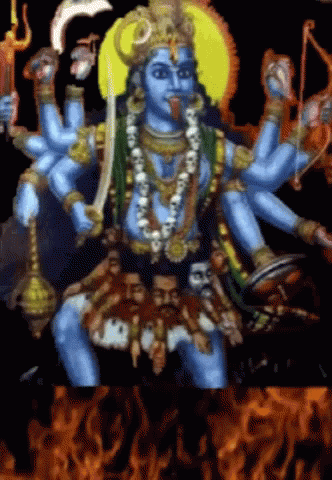
Number of times to chant this mantra 108 daily for 40 days
Who can recite the Kalika-Yei mantra? Anyone
Chant this mantra facing East or North direction
5. Kali Gayatri Mantra
The Kali Gayatri mantra is one of the most useful mantras if you seek quick success in life. For the natives struggling at growing in their careers, the Kali Gayatri mantra comes to the rescue as its vibrations fill the native with positive energies. The mantra provides success, well-being and happiness to the native.
The Kali Gayatri mantra is:
|| ॐ महा काल्यै
छ विद्महे स्मसन वासिन्यै
छ धीमहि तन्नो काली प्रचोदयात ||
Om Maha Kalyai
Cha Vidmahe Smasana Vasinyai
Cha Dhimahi Tanno Kali Prachodayat
Meaning - Om Great Goddess Kali, the One and only one, who resides in the Ocean of Life and in the Cremation Grounds that dissolve the world. We focus our energies on you, may you grant us boons and blessings.
Benefits of chanting the Kali Gayatri mantra
As the native chants the kali Gayatri mantra, his mind becomes divinely transformed and passes from the gross state of worldly affairs into Kali’s subtle light of pure consciousness.
The Kali Gayatri mantra helps the native in accomplishing tasks successfully.
The mantra recitation is said to free the native from all fears of life to help him take the needed step.
Best time to recite the Kali Gayatri mantra After sunset
Number of times to chant this mantra 9 times daily for 40 days
Who can recite the Kali Gayatri mantra? Anyone
Chant this mantra facing East or North direction
6. Dakshina Kali Dhyan Mantra
Dhyan is a state of mind which helps you connect with the divine in numerous ways. Also called the Karpuradi Stotra, the regular chanting of the Dhyan mantra aids the native to connect with the energies of Maa Kali, which are fearfulness, courage, boldness, valour and more. However, to have the best of this mantra, the native needs to chant the Dakshina Kali Dhyan mantra regularly and with the correct pronunciation.
The Dakshina Kali Dhyan mantra is:
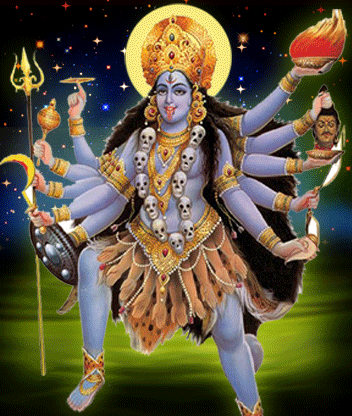
|| ॐ ह्रीं ह्रीं ह्रुं ह्रुं क्रीं क्रीं क्रीं दक्षिणकालिके क्रीं क्रीं क्रीं ह्रुं ह्रुं ह्रीं ह्रीं ||
Om Hreem Hreem Hrum Hrum Kreem Kreem Kreem Dakshina Kalike Kreem Kreem Kreem Hrum Hrum Hreem Hreem
Meaning - Salutations to the Goddess who is the preserver of earth and saves the universe from all kinds of troubles.
Benefits of chanting Dakshina Kali Dhyan mantra
Recitation of this mantra releases you from the binding web of adult pretence.
Dakshina Kali Dhyan mantra energises you with positive energy so that you can achieve your goal no matter how tough.
The chanting of the Dakshina Kali Dhyan mantra brings peace, happiness, and satisfaction to the native.
Best time to recite the Dakshina Kali Dhyan mantra After sunset
Number of times to chant this mantra 9 times daily for 40 days
Who can recite the Dakshina Kali Dhyan mantra? Anyone
Chant this mantra facing East or North direction
7. Kali Chants
Apart from Kali mantras, there are also some Kali Chants a native can chant to seek the blessing of Goddess Kali.
The Dakshina Kali Dhyan mantra is:
ॐ काली, काली! ॐ काली, काली!
नमोस्तुते, नमोस्तुते, नमो!
नमोस्तुते, नमोस्तुते, नमो ||
Om Kali, Kali! Om Kali, Kali
Namostute, namostute, namo
Namostute, namostute, namo
आनंद मां आनंद मां कलि
आनंद मां आनंद मां कलि
आनंद मां आनंद मां कलि
ॐ काली माँ ||
Ananda Maa Ananda Maa Kali
Ananda Maa Ananda Maa Kali
Ananda Maa Ananda Maa Kali
Om Kali Maa
Overall benefits of Chanting the Kali mantras
The Kali mantras are one of the most powerful mantras in astrology and thus hold the capability to protect you from the hexes.
The Kali mantra chanting resonates with vibrations that calm you down and help you in attaining peace.
Reciting the Kali mantra awakens the inner consciousness of the person, and thus brings stability to his or her life.
Chanting the Kali mantra helps you maintain cordial and harmonious relations with your family and loved ones.
If you chant the Kali mantra regularly and with full devotion, the Goddess shall bring an end to all your sufferings.
Chanting the mantra on a regular basis safeguards the native from the disasters that may bestow upon his health, wealth and happiness.
The regular chanting of the Kali mantra gives you strength thereby making you more powerful than the problems you face.

The chanting of the Maa Kali mantra helps in making your life more radiant. You shall feel the positive vibes if you chant these mantras on a regular basis.
The mantras aid the native's financial position and help in removing all debts.
In terms of love life too, reciting the Kali mantra can help in resolving issues surrounding your love life and can help you in achieving success all the way.
It provides success, happiness, progress, and well-being.
The chanting of the mantra, and the vibrations that release from it, help in uplifting your health.
The Kali mantras ward away the bad eye and any evil that attempts to stop your growth in life.
The Mantras help you to find a good match for matrimonial purposes. Chanting of Kali Mantra ensures any delay in marriage is resolved.
The chanting of Goddess Kali Mantra brings stability to life. You can decide what is good for your life. You always end up with good decisions.
I hope you enjoyed this blog more to follow shortly,
Culture Calypso’s Blog 🪷🪬🧿
#ma kali#hinduism#Indian#shiva#spiritualjourney#goddess#dark goddess#deity#my blogs#spirituality#religion#parvati
59 notes
·
View notes
Text
oudica or Boudicca (/ˈbuːdɪkə, boʊˈdɪkə/, from Brythonic *boudi victory, win + *-ka having suffix, i.e. 'Victorious Woman', known in Latin chronicles as Boadicea or Boudicea, and in Welsh as Buddug (Welsh pronunciation: [bɨðɨɡ])), was a queen of the ancient British Iceni tribe, who led a failed uprising against the conquering forces of the Roman Empire in AD 60 or 61. She is considered a British national heroine and a symbol of the struggle for justice and independence.
Boudica
Queen of the Iceni
Opie's painting of Boudica
John Opie's Boadicea Haranguing the Britons
Born
British Isles
Died
60/61
Spouse
Prasutagus
Issue
2 daughters
Boudica's husband Prasutagus, with whom she had two daughters, ruled as a nominally independent ally of Rome. He left his kingdom jointly to his daughters and to the Roman emperor in his will. When he died, his will was ignored, and the kingdom was annexed and his property taken. According to the Roman historian Tacitus, Boudica was flogged and her daughters raped. The historian Cassius Dio wrote that previous imperial donations to influential Britons were confiscated and the Roman financier and philosopher Seneca called in the loans he had forced on the reluctant Britons.
In 60/61, Boudica led the Iceni and other British tribes in revolt. They destroyed Camulodunum (modern Colchester), earlier the capital of the Trinovantes, but at that time a colonia for discharged Roman soldiers. Upon hearing of the revolt, the Roman governor Gaius Suetonius Paulinus hurried from the island of Mona (modern Anglesey) to Londinium, the 20-year-old commercial settlement that was the rebels' next target. Unable to defend the settlement, he evacuated and abandoned it. Boudica's army defeated a detachment of the Legio IX Hispana, and burnt both Londinium and Verulamium. In all, an estimated 70,000–80,000 Romans and Britons were killed by Boudica's followers. Suetonius, meanwhile, regrouped his forces, possibly in the West Midlands, and despite being heavily outnumbered, he decisively defeated the Britons. Boudica died, by suicide or illness, shortly afterwards. The crisis of 60/61 caused Nero to consider withdrawing all his imperial forces from Britain, but Suetonius's victory over Boudica confirmed Roman control of the province.
Interest in these events was revived in the English Renaissance and led to Boudica's fame in the Victorian era and as a cultural symbol in Britain.
Culture Calypso’s Blog

1 note
·
View note
Text
Todays Recipes Of Skyrim blog is Lavender And Honey Bread!
🍞🍯🍞🍯🍞🍯🍞🍯🍞🍯🍞🍯🍞🍯🍞🍯🍞🍯

This is a popular bread in Whiterun, where lavender grows wild and countless beehives are kept to provide the Honningbrew Meadery with enough honey for their mead production. The honey and lavender are such a natural pairing that they are combined not only for the mead but also in this flavorful loaf.
Prep: 15 minutes
Rising: 1 hour
Baking: 25-30 mins
Makes: 1 loaf
Pairs well with: Honningbrew Mead, fresh berry jam & butter

Ingredients:
1 1/4 cups warm milk
1/4 cup 1/2 stick unsalted butter
1/3 cup honey
1 heaping tablespoon culinary lavender
2 teaspoons instant dry yeast
1 teaspoon salt
2 cups whole wheat flour
2 cups all-purpose flour

Directions:
1. Lightly butter the sides of an 8x5 inch 1 pound bread loaf pan & set aside. In a large bowl, combine the milk, butter & honey, stirring until the honey has dissolved. Stir in the lavender, yeast, & salt, along with 1 cup of flour. Continue adding flour 1 cup at a time until the dough is no longer sticky add more flour if necessary.
2. Turn the dough out onto a lightly floured surface& knead for several minutes, until the dough bounces back slightly when poked. Form into an oblong shape and settle gently into loaf pan. Cover lightly with plastic or a warm towel & set somewhere warm to rise for 1 hour until roughly doubled and in size & has a nice shape.
3. Once the dough has risen, preheat to 400F & bake for 25-30 minutes or until a toothpick inserted into the middle of the loaf comes out clean. Allow to cool before slicing.

*TIP*
Culinary lavender can be acquired from alchemists but is more readily purchased at health food stores or online.

I hope you enjoyed this blog more to follow soon
Regards,
Culture Calypso’s Blog 🍞🍯
#my blogs#gaming#skyrim#cooking#elder scrolls#taverncore#baking#homemade bread#lavender flowers#honeycore#cottagecore#mediveal#Spotify
95 notes
·
View notes
Text
Iconoclasm: The destruction of God/Goddess statues, figurines & paintings
Why do so many statues have broken noses, body parts ECT This is a question that a lot of people have asked. If you have ever visited a museum, you have probably seen ancient sculptures such as the one below—a Greek marble head of the poet Sappho currently held in the Glyptothek in Munich, with a missing nose:
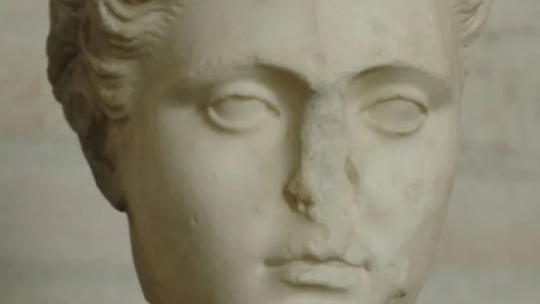
Bibi Saint-Pol, Public Domain, Wikimedia Commons
A smashed or missing nose is a common feature on ancient sculptures from all cultures and all time periods of ancient history. It is by no means a feature that is confined to sculptures of any particular culture or era. Even the nose on the Great Sphinx, which stands on the Giza Plateau in Egypt alongside the great pyramids, is famously missing:

If you have seen one of these sculptures, you have probably wondered: “What happened to the nose?” Some people seem to have a false impression that the noses on the majority of these sculptures were deliberately removed by someone.
It is true that a few ancient sculptures were indeed deliberately defaced by people at various times for different reasons. For instance, there is a first-century AD Greek marble head of the goddess Aphrodite that was discovered in the Athenian Agora. You can tell that this particular marble head was at some point deliberately vandalized by Christians because they chiseled a cross into the goddess’s forehead.

This marble head, however, is an exceptional case that is not representative of the majority of ancient sculptures that are missing noses. For the vast majority of ancient sculptures that are missing noses, the reason for the missing nose has nothing to do with people at all. Instead, the reason for the missing nose simply has to do with the natural wear that the sculpture has suffered over time.
The fact is, ancient sculptures are thousands of years old and they have all undergone considerable natural wear over time. The statues we see in museums today are almost always beaten, battered, and damaged by time and exposure to the elements. Parts of sculptures that stick out, such as noses, arms, heads, and other appendages are almost always the first parts to break off. Other parts that are more securely attached, such as legs and torsos, are generally more likely to remain intact.
You are probably familiar with the ancient Greek statue shown below. It was found on the Greek island of Melos and was originally sculpted by Alexandros of Antioch in around the late second century BC. It is known as the Aphrodite of Melos or, more commonly, Venus de Milo. It famously has no arms:
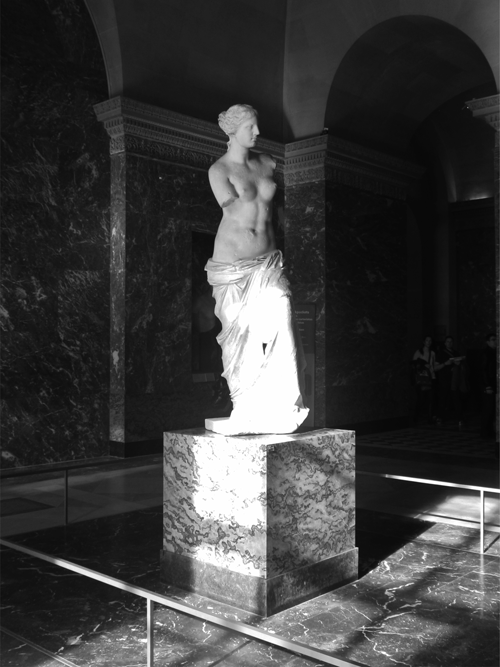
Once upon a time, the Aphrodite of Melos did, in fact, have arms, but they broke off at some point, as arms, noses, and legs often tend to do. The exact same thing has happened to many other sculptures’ noses. Because the noses stick out, they tend to break off easily.
Greek sculptures as we see them today are merely worn-out husks of their former glory. They were originally brightly painted, but most of the original pigments faded or flaked off long ago, leaving the bare, white marble exposed. Some exceptionally well-preserved sculptures do still retain traces of their original coloration, though.
Ever wonder why the Sphinx has no nose? Why many Ancient Egyptian artifacts are found without an arm, a nose, a head, or another body part? It’s not from wear and tear, or the natural damage of thousands of years, they were a calculated effort by Ancient Egyptians to strip the figure, god, or king of their power especially in the afterlife.

The destruction of statues, figurines, and paintings, known as iconoclasm, is the subject of a new exhibition in St. Louis, Missouri, USA, which will attempt to understand the cultural practice of defacing Ancient Egyptian monuments.
No matter if they were the former regime seeking to strip the power of those they overthrew, grave robbers looking to strip tombs of the valuables yet still feared the power of those that are dead, or even early Christians who wished to communicate the power of the new God over the pagan polytheists, all defaced monuments to thumb their nose at the gods, pharaohs, and ancient Egyptian elite.
When Set wished to destroy his brother Osiris, he could not kill an immortal god, so what to do? Dismember him, scatter his body parts across the country, and Osiris would no more be able to challenge his brother. This ritual formed the belief in Ancient Egyptians that dismemberment was the only means to break the power of the divine, an effort that needed to be undertaken for one reason or another over the centuries.

Ancient Egyptians believed that their mummies, monuments, and statues served as a vessel for divine energy to fill. When making offerings, it was thought that the deity would fill the statue in the home, temple, or necropolis, with the dead wielding just as much power as the living.
Edward Bleiberg states in his essay on iconoclasm that “Once the deity has occupied it, the sculpture or relief containing the god becomes a piece of equipment for conducting the essential rituals of offering and worship. The rituals performed with images center specifically on offering and receiving food, drink, clothing, and other necessities. Deceased kings and deceased humans were able to make such offerings to the gods in the afterlife by means of images placed in temples for that purpose. When a statue or image is disabled, it is sometimes clear that it is this particular purpose of the image that has been attacked.”
From time to time, a Pharaoh, elite, or great figure would fall out of favor. The biggest example being Hapshepsut who, along with her husband, attempted to create one god that stood above the other ancient deities. The Cult of Aten was a scandal for Ancient Egyptians, and after the Aten revolution was suppressed, the old regime systematically defaced every statue of Hatshepsut in the country as a means of weakening Aten.
Pharaohs were so anxious about their image being defaced that a royal decree passed in the First Intermediate Period stated that anyone who defaced a statue lost their right to a soul and a place in the afterlife.
Egyptologist Betsy Bryan has established that damaging a mummy as a means of attacking a person in the next world started in Egypt at the very beginning of its history, during the Pre-Dynastic period. This action was in fact analogous to the attacks on statues and reliefs that would occur in the historical period of Egyptian history.
In every era of the following three thousand years of ancient Egyptian history, there is good evidence that the practice of damaging images of the human form, as either protection from, or an attack on, perceived enemies, remained common.
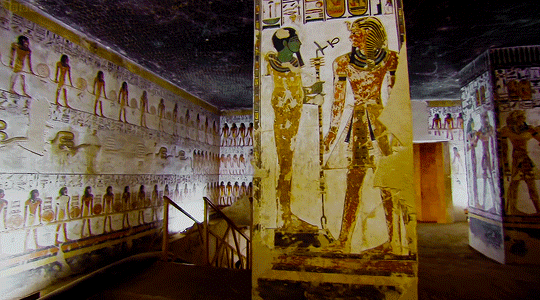
So, why the nose? And why not just break the statue into smithereens? For the Ancient Egyptians, the nose was essential in re-creating life after death. The incense placed in the nose allowed the breath of life to enter the soul of the deceased. When tomb-raiders destroyed and looted a tomb, they still feared the power of the pharaoh, so damaging the nose was an important way to avoid punishment. If the buried pharaoh couldn’t continue his life after death, he wouldn’t be a witness when those tomb-raiders were dead themselves.
Yet total destruction of a statue was regarded as less efficacious than partial damage, as many examples cited here show. In his late fourth- and early fifth-century CE preaching, Saint Augustine recommended partial breakage of polytheistic statues, saying, “Brethren, I deem it more shameful for Hercules to have his beard shaved than to have his head taken off.”

In this case, shaving Hercules’s beard was thought to show that his statue was powerless in the face of Christianity. The presence of damaged statues of Greek or Egyptian gods was understood to definitively demonstrate the power of Christianity and the helplessness of the gods of earlier polytheistic religions.
Thus, Christian monks in Egypt damaged the parts of the temples that had been dedicated for a deity or for ritual, damaging but not destroying. In a way, they updated the historical statues to reflect the times. While we in the modern-day see this as an attack on civilization, the early converts saw it and an enduring testament to the biggest revolution in spirituality up to that point; the transition from polytheism to monotheism and the ancient world to the pre-modern.
When the Christians of Egypt saw that the polytheistic Egyptians still made tributes and rituals in the sight of the Sphinx of Giza, they cracked off the nose to make the Sphinx eternally flawed and incomplete which was successful in breaking the true power that the Sphinx had over Egypt. Not even the Egyptians knew what the meaning and nature of the Sphinx was, it was the embodiment of enigma, mystery, secrets, and thus power and unity. Even today secrets have a psychological effect to bond people together. By breaking the nose, the mystic vanished. No retribution came. So the mystery of the Sphinx was revealed, that it had no true secret.
Bleiberg counters the idea that Muslims defaced these statues, saying it was far more likely the Christians as the Christians communicated the power of God by speaking the language of the pagans whereas Muslims just mined tombs, statues, and temples for valuable stones. Muslim conquerors were not interested in demonstrating to the pagans the greatness of God, they felt that the dismantling of Ancient Egypt for material concerns would demonstrate to the pagans what happens to a civilization that doesn’t keep the true god.

So, it many ways the Christians continued the same practice of the Ancient Egyptians, and mark a continuity of Egyptian customs under a new religious creed. The Christians would continue this concept through the medieval ages, with Constantinople carrying out an empire-wide iconoclasm numerous times. Even today we burn effigies and symbols of figures we hate as an attack on the image, and thus power, of the individual and system they represent. So, the practice of chiseling a nose off should not be a shock to us today.
I hope you enjoyed this blog,
Culture Calypso’s Blog
#my blogs#spirituality#history#paganism#religion#greek mythology#egyptology#giza#egyptian#greek and roman mythology#soundcloud#iconoclasm
1 note
·
View note
Text
Today’s Recipes Of Skyrim Blog is…
Snowberry Crostata 🥧❄️🗻

Note: this is one of the best pies I’ve ever had in my life I will be making it every Yule/Saturnalia!
This rustic berry tart is most commonly made over the hearthfires of home kitchens, but can occasionally be found for sale in a few taverns and inns as well. The recipe makes a dessert that’s just the side of tart, and perfect to share with your traveling companions.

Prep: 15 minutes
Baking: 40 minutes
Makes: 8-10 servings
Pairs well with: San’s spiced wine, assorted cheeses & nuts
Ingredients:
1 recipe sweet crostata dough or 2 pie shells
1 cup granulated sugar
2 eggs
1 tsp Nord spices ( 1 1/2 tablespoons ground cardamom, 3/4 teaspoon ground cinnamon, 1 teaspoon ground mace, 1/4 teaspoon ground cloves, 1/8 teaspoon grains of paradise)
1/2 cup ( 1 stick) un-salted butter, melted
2 teaspoons almond or vanilla extract
1 cup all purpose flour
12 ounces fresh or frozen cranberries
1/2 cup sliced almonds (optional)
1 egg beaten, for glazing (so 3 eggs total)
1 tablespoon powdered sugar for dusting (use sieve or colander)

Directions:
1. Preheat the oven to 325°F line a large baking sheet with parchment paper. Roll out the sweet Christata dough or pie dough in a roughly round shape to about 1/8 of an inch thick, and drape it over the large baking sheet lined with parchment paper. Leave the excess dough draped over the sides and prick the bottom all over with the fork to keep it from bubbling up too much. Cover with plastic wrap and place in the refrigerator while you make the filling.
2. In a medium bowl, combine the granulated sugar, eggs, Nord spices, melted butter, and almond or vanilla extract. Whisk in the flour until you have a thick better.
3. Take the dough from the refrigerator and pour half the cranberries onto it, spreading them evenly but leaving a little space around the edge of the dough. Pour the batter over the cranberries. Sprinkle the almonds over the filling, then top with the remaining cranberries, pressing them gently into the batter.
4. Fold the hanging edges of the dough inward & over the filling to keep the berries contained. Brush with the beaten egg to glaze. Bake for about 40 minutes, or until a toothpick poked in the middle of the crostata or pie dough comes out clean. Allow to cool for about 10 minutes, then dust with powdered sugar. ENJOY!!!
I hope you enjoyed this blog more to follow soon!
Regards,
Culture Calypso’s Blog 🥧❄️🗻

#my blogs#gaming#skyrim#cooking#elder scrolls#holydays#soundcloud#taverncore#baking#yuletide#saturnalia
9 notes
·
View notes
Text
This blog is on the Scandinavian Yule cat
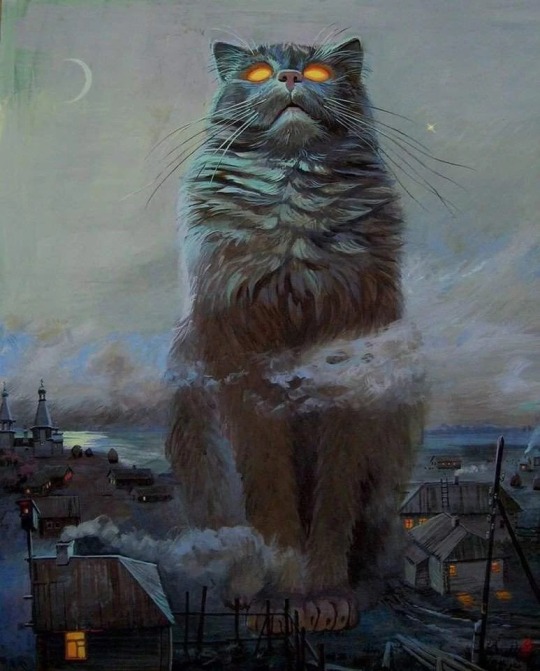
Each Christmas, Iceland’s Yule Cat Takes Fashion Policing to the Extreme
The Jólakötturinn will make you thankful for those Christmas socks
Santa Claus may be the ruby-cheeked patron of the holiday spirit in the United States, but in other countries he’s often accompanied by helpers of all kinds, who can quite frequently be terrifying. The Krampus of Central Europe is one example that comes to mind—a demonic spirit bound by St. Nicholas to kidnap naughty children and beat them with branches. But as far as creepy Christmas monsters go, Iceland’s Jólakötturinn is by far the most fashion-forward.

For most kids who celebrate Christmas, new clothes probably sit just above lumps of coal on the good present scale. But according to an Icelandic tradition, getting new socks before Christmas might just save your life. That’s because the Jólakötturinn, or Yule Cat, eats anyone who hasn’t received new clothes by the time Christmas rolls around, Matthew Hart writes for Nerdist.
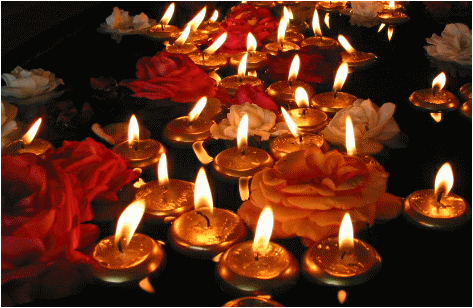
The story of the Jólakötturinn likely dates back to the Dark Ages, though the oldest written accounts are from the 19th century. In any case, much like the Krampus, the Yule Cat has long been a Christmas-time enforcer of good behavior, Miss Cellania writes for Mental Floss. According to Icelandic tradition, anyone who finished their chores before Christmas would get new clothes as a reward. Meanwhile, lazy children who didn’t get their work done would have to face the Jólakötturinn.
For starters, the Jólakötturinn is no mere kitten—it towers above the tallest houses. As it prowls about Iceland on Christmas night, the Yule Cat peers in through the windows to see what kids have gotten for presents. If new clothes are among their new possessions, the big cat will move along. But if a child was too lazy to earn their new socks, the Jólakötturinn will eat their dinner, before moving on to the main course: the child herself, Hart writes.
“This is the kind of message Icelanders like to send out in their folklore,” Haukur S. Magnússon writes for the Reykyavík Grapevine. “If you do not have the money or means of acquiring new items of clothing before the festival of lights, you will be eaten by a gigantic cat.”

Presumably the threat of being eaten by the Jólakötturinn is also meant to inspire generosity in children who don’t have to fret about the Yule Cat, as giving clothes to the less-fortunate would grant them protection from the monstrous feline. But the giant beast isn’t even the only human-eating Christmas monster that Icelanders have the misfortune of having to face every year. There’s also the Jólakötturinn’s owners: the trolls Grýla, Leppalúði and their 13 children, who are collectively known as the “Yule Lads,” Magnússon writes.
So if you ever find yourself celebrating Christmas in Iceland, make sure to get some new clothes under the tree—those socks will come in handy when the Yule Cat peers in your window.

I hope you enjoyed this blog more to follow
Happy holidays,
Culture Calypso’s Blog 🐱🎄
19 notes
·
View notes
Text
Today’s blog is on the Roman holiday Saturnalia
🪐🪐🪐🪐🪐🪐🪐🪐🪐🪐🪐🪐🪐🪐🪐🪐🪐
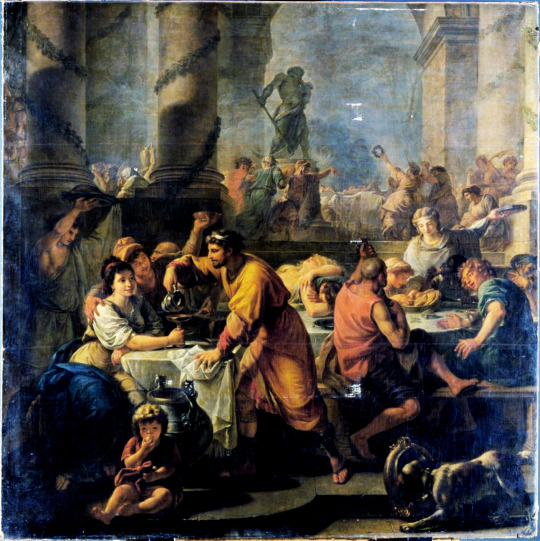

Saturnalia, the most popular of Roman festivals. Dedicated to the Roman god Saturn, the festival’s influence continues to be felt throughout the Western world.
Originally celebrated on December 17, Saturnalia was extended first to three and eventually to seven days. The date has been connected with the winter sowing season, which in modern Italy varies from October to January. Remarkably like the Greek Kronia, it was the liveliest festival of the year. All work and business were suspended. Slaves were given temporary freedom to say and do what they liked, and certain moral restrictions were eased. The streets were infected with a Mardi Gras madness; a mock king was chosen (Saturnalicius princeps); the seasonal greeting io Saturnalia was heard everywhere. The closing days of the Saturnalia were known as Sigillaria, because of the custom of making, toward the end of the festival, presents of candles, wax models of fruit, and waxen statuettes which were fashioned by the sigillarii or manufacturers of small figures in wax and other media. The cult statue of Saturn himself, traditionally bound at the feet with woolen bands, was untied, presumably to come out and join the fun.

The influence of the Saturnalia upon the celebrations of Christmas and the New Year has been direct. The fact that Christmas was celebrated on the birthday of the unconquered sun (dies solis invicti nati) gave the season a solar background, connected with the kalends of January (January 1, the Roman New Year) when houses were decorated with greenery and lights, and presents were given to children and the poor. Concerning the gift candles, the Romans had a story that an old prophecy bade the earliest inhabitants of Latium send heads to Hades and phota to Saturn. The ancient Latins interpreted this to mean human sacrifices, but, according to legend, Hercules advised using lights (phos means “light” or “man” according to accent) and not human heads.
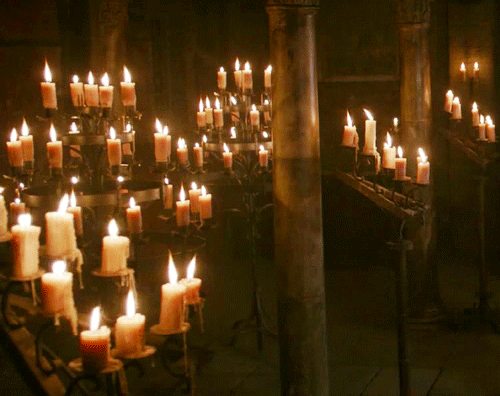
Saturn, Latin Saturnus, in Roman religion, the god of sowing or seed. The Romans equated him with the Greek agricultural deity Cronus. The remains of Saturn’s temple at Rome, eight columns of the pronaos (porch), still dominate the west end of the Forum at the foot of the Clivus Capitolinus. The temple goes back to the earliest records of the republic (6th century BCE). It was restored by Lucius Munatius Plancus in 42 BCE and, after a fire, in the 4th century CE. It served as the treasury (aerarium Saturni) of the Roman state. Saturn’s cult partner was the obscure goddess Lua, whose name is connected with lues (plague or destruction), but he was also associated with Ops, another obscure goddess (perhaps the goddess of abundance), the cult partner of Consus, probably a god of grain storage.

In Roman myth Saturn was identified with the Greek Cronus. Exiled from Olympus by Zeus, he ruled Latium in a happy and innocent golden age, where he taught his people agriculture and other peaceful arts. In myth he was the father of Picus.
Saturn’s great festival, the Saturnalia, became the most popular of Roman festivals, and its influence is still felt in the celebration of Christmas and the Western world’s New Year. The Saturnalia was originally celebrated on December 17, but it was later extended to seven days. It was the merriest festival of the year: all work and business were suspended; slaves were given temporary freedom to say and do what they liked; certain moral restrictions were eased; and presents were freely exchanged. The weekday Saturday (Latin Saturni dies) was named for Saturn.

By the beginning of December, writes Columella, the farmer should have finished his autumn planting (De Re Rustica, III.14). Now, with the approach of the winter solstice (December 25 in the Julian calendar), Saturnus, the god of seed and sowing (Latin satus) was honored with a festival. The Saturnalia officially was celebrated on December 17 (XVI Kal. Jan.) and, in Cicero's time, lasted seven days (counting inclusively), from December 17 to 23. Augustus limited the holiday to three days, so the civil courts would not have to be closed any longer than necessary (Macrobius, Saturnalia, I.10.4), and Caligula extended it to five (Suetonius, Life of Caligula, XVII; Dio, Roman History, LIX.6.4), the fifth day restored by Claudius after it once had been abolished (Dio, LX.25.8). Still, everyone seems to have continued to celebrate for a full week, extended, says Macrobius, by celebrating the Sigillaria on the last day of Saturnalia, so named for the small earthenware figurines (sigillaria) that were sold then (I.10.24).
In the Saturnalia, Macrobius creates an imaginary symposium among pagan intellectuals in which he offers an explanation for the varying length of the holiday. Originally, the festival was celebrated on one day only, the fourteenth before the Kalends of January. With the Julian reform of the calendar, however, two days were added to December, and the Saturnalia was celebrated sixteen days before the Kalends (December 17) "with the result that, since the exact day was not commonly known—some observing the addition which Caesar had made to the calendar and others following the old usage—the festival came to be regarded as lasting for more days than one" (I.10.2). The original day was given over to the Opalia, honoring Ops, who personified abundance and the fruits of the earth, and was the consort of Saturn. As the two deities represented the produce of the fields and orchards, so they also were thought to represent heaven and earth. It was for this reason, says Macrobius, that the two festivals were celebrated at the same time, the worshipers of Ops always sitting in prayer so that they touched the earth, mother of all (I.10.20).

In the Roman calendar, the Saturnalia was designated a holy day, or holiday, on which religious rites were performed. Saturn, himself, was identified with Kronos, and sacrificed to according to Greek ritual, with the head uncovered. The Temple of Saturn, the oldest temple recorded by the pontiffs, had been dedicated on the Saturnalia, and the woolen bonds which fettered the feet of the ivory cult statue within were loosened on that day to symbolize the liberation of the god. It also was a festival day. After sacrifice at the temple, there was a public banquet, as well as a lectisternium (in which an image of the god was placed as if in attendance), which Livy says was introduced in 217 BC. "For a day and a night the cry of the Saturnalia resounded through the City, and the people were ordered to make that day a festival and observe it as such for ever" (History of Rome, XXII.1.19). Afterwards, according to Macrobius, the celebrants shouted Io, Saturnalia at a riotous feast in the temple (I.10.18).
The Saturnalia was the most popular holiday of the Roman year. Catullus describes it as "the best of days" (Poems, XIV), and Seneca complains that the "whole mob has let itself go in pleasures" (Epistles, XVIII.3). Pliny the Younger writes that he retired to his room while the rest of the household celebrated (Epistles, II.17.24). It was an occasion for visits to friends and the presentation of gifts, particularly wax candles (cerei), perhaps to signify the returning light after the solstice, and sigillaria. Martial wrote Xenia and Apophoreta for the Saturnalia, both of which were published in December and intended to accompany the "guest gifts" that were given at that time of year. Aulus Gellius relates that he and his Roman compatriots would gather at the baths in Athens, where they were studying, and pose difficult questions to one another on the ancient poets, a crown of laurel being dedicated to Saturn if no-one could answer them (Attic Nights, XVIII.2).

During the holiday, restrictions were relaxed and the social order inverted. Gambling was allowed in public. Slaves were permitted to use dice and did not have to work. Instead of the toga, colorful dinner clothes (synthesis) were permitted in public, as was the pileus, a felt cap normally worn by the manumitted slave that symbolized the freedom of the season (Martial, Epigrams, XIV.1). Within the family, a Lord of Misrule was chosen, a role once occupied by a young Nero, who derisively commanded his younger step-brother Britannicus to sing (Tacitus, Annals, XIII.15).
Slaves were treated as equals, allowed to wear their masters' clothing, and be waited on at meal time in remembrance of an earlier golden age thought to have been ushered in by the god. In the Saturnalia, Lucian has the god himself declare that "During My week the serious is barred; no business allowed. Drinking, noise and games and dice, appointing of kings and feasting of slaves, singing naked, clapping of frenzied hands, an occasional ducking of corked faces in icy water—such are the functions over which I preside." Statius recounts a "December tipsy with much wine, and laughing Mirth and wanton Wit," remembering "the glad festival of our merry Caesar and the banquet's drunken revel" (Silvae, I.6.1ff; also Suetonius, Life of Domitian, IV.1; Dio, LXVII.4.4). Figs, nuts, dates and other dainties were showered on the people, women and children, men and senators alike, and bread and wine served while guests were entertained by women fighting in the arena and cranes were hunted by dwarfs.
This equality was temporary, of course. Petronius speaks of an impudent slave, who had burst out laughing, being asked whether it was December yet (Satyricon, LVIII). And Dio writes of Aulus Plautius cajoling his troops in his invasion of Britain, who hesitated, "indignant at the thought of carrying on a campaign outside the limits of the known world" (LX.19.3). Only when they were entreated by a former slave dispatched by Claudius did they relent, derisively shouting Io, Saturnalia at the freedman who acted like an emperor.
If a time of merriment, the season also was an occasion for murder. The Catiline conspirators intended to fire the city and kill the Senate on the Saturnalia, when many would be preoccupied with the celebration (Cicero, The Third Oration Against Catiline, X). Caracalla plotted to murder his brother then (Dio, LXXVIII.2.1), and Commodus was strangled in his bath on New Year's eve (Herodian, History of the Empire, I.17.11).

At the end of the first century AD, Statius, besotted from Domitian's Saturnalian feast, exulted: "Who can sing of the spectacle, the unrestrained mirth, the banqueting, the unbought feast, the lavish streams of wine? Ah! now I faint, and drunken with thy liquor drag myself at last to sleep. For how many years shall this festival abide! Never shall age destroy so holy a day! While the hills of Latium remain and father Tiber, while thy Rome stands and the Capitol thou hast restored to the world, it shall continue" (Silvae, I.6.98ff). And the Saturnalia did continue to be celebrated as the Brumalia (from bruma, "the shortest day," winter solstice, cf. Varro, De Lingua Latina, VI.8) down to the Christian era, when, by the middle of the fourth century AD, its festivities were becoming absorbed in the celebration of Christmas.
In the Julian reform of the Roman calendar on January 1, 45 BC, Caesar added two additional days to the end of December. But, because they fell between the Ides and the next Kalends, Caesar was confronted either with having the Saturnalia celebrated on the same "day" (i.e., the same number of days after the Ides) or on the same "date" (its position in the month relative to the following Kalends). He chose to leave the festival on the same day, even though this meant changing its date.
Macrobius says that the Saturnalia occurred on "the fourteenth before the Kalends of January" in the Republican calendar. In a month that then had only twenty-nine days, a.d.XIV.Kal.Jan. is December 17. This also was its "day" in the Julian calendar, with its thirty-one day month, although the "date" now is a.d.XVI.Kal.Jan., just as Caesar had intended in his reform of the calendar.
Feeney provides an intriguing example of the consequences of the new calendar in the person of Mark Antony, who was born in 83 BC on the day after the Ides of January (January 14). In the Republican calendar, January had twenty-nine days and Antony's birthday, since he was born after the Ides, was counted down to the next Kalends. That day was the seventeenth before the Kalends of February. In the reformed Julian calendar, two days were added to January, which now had thirty-one. In 45 BC, celebrating his thirty-eighth birthday for the first time under the Julian calendar, Antony had to chose whether to recognize it on the same date (the seventeenth day before the Kalends), as he always had done—even though that date now was two days later (on the third day after the Ides)—or on the same day (the day after the Ides). He chose to observe his birthday on the same day.
But this date did not exist in the calendar of the Republic. When Antony was born, there was no nineteenth day before the Kalends of February, since only seventeen days could be counted back. Nineteen days would be the day before the Ides of January, not the day after. Antony's birthday is the anniversary of the "day" he was born, but it is not the "date" of his birth simply because that day did not exist in the Julian calendar.
When Antony committed suicide in 30 BC, dying in Cleopatra's arms, his memory was damned by the Roman Senate (damnatio memoriae). He already had been declared a public enemy (Suetonius, Augustus, XVII.2) and his statues torn down when Octavian entered Alexandria (Plutarch, Antony, LXXXVI.5). The Senate also ordered that monuments to Antony be defaced or dismantled, his honors rescinded, his descendants forbidden to use the praenomen Marcus, and "the day on which he had been born accursed" (dies nefastus), a day unfit for public business (Dio, LI.19.3; Plutarch, Cicero, XLIX.6).
And yet the greatest damnation was accidental. Not only was his natal day condemned but, with the reform of the Roman calendar by Julius Caesar, it no longer even existed. It was as if Mark Antony had never been born.
The first reference to December 25 as the Nativity of Jesus occurs in a section of the Chronography of AD 354 known as the Calendar of Philocalus, which, even by this late date, still identified December 17 as ludi Saturnalia.
Half a century later, when Macrobius wrote the Saturnalia, he placed the celebration in the house of Vettius Agorius Praetextatus, a pagan aristocrat who once had served as praetorian prefect during the reign of Valentinian II and been consul designate before his death. A correspondent of Symmachus (Letters, I.44-55), he was characterized by the historian Ammianus Marcellinus as "a senator of noble character and old-time dignity" (Roman History, XXII.7.6.), an honest and upright man who, "although he did nothing to gain favour, yet everything that he did was looked upon with favour" (XXVII.9.8-10).
When Praetextatus died in AD 384, his death was scornfully dismissed by Jerome (the translator of the Latin Vulgate). "A few days ago the highest dignitaries of the city walked before him as he ascended the ramparts of the capitol like a general celebrating a triumph; the Roman people leapt up to welcome and applaud him, and at the news of his death the whole city was moved. Now he is desolate and naked, a prisoner in the foulest darkness, and not, as his unhappy wife falsely asserts, set in the royal abode of the milky way" (Letters, XXIII.3). He is referring to a eulogy that the wife of Praetextatus, Aconia Fabia Paulina, herself the daughter of a consul, had written for her husband of forty years and later had inscribed on his funeral monument. Rather, Jerome asserts, he is "in Tartarus [hell]" (XXIII.2).
December 17 was recognized as the date of the Saturnalia as late as AD 448, when it was notated in the ecclesiastical calendar or laterculus ("list") of Polemius Silvius. But now, deprived of its pagan significance, it is identified only as feriae servorum ("festival of the slaves").

The picture above may seem a strange accompaniment to an essay on the Saturnalia, but this carving of a jolly fellow on a Mosel wine ship, which is in the Rheinisches Landesmuseum (Trier, Germany), seems to capture the spirit of the celebration as well as any.
I hope you enjoyed this blog more to follow soon.
Regards.
Culture Calypso’s Blog 🪐
#my blogs#spirituality#history#paganism#religion#holydays#greek and roman mythology#saturnalia#saturn#Spotify
0 notes
Text
Today’s Recipes Of Skyrim Blog is…
COMPANION MEATBALL BAKE
🥔🧆🥔🧆🥔🧆🥔🧆🥔🧆🥔🧆🥔🧆🥔🧆🥔🧆

This deceptively simple dish is a favorite among Whiterun’s companions, where it is always served in a round shape to symbolize their equality with one another. They fight together, drink together, and, perhaps most importantly, feast together in the hall of Jorrvaskr. As the companions are proficient hunters, these meatballs might be made of whatever has been freshly caught, be it bear, venison, boar, mammoth, or what have you.
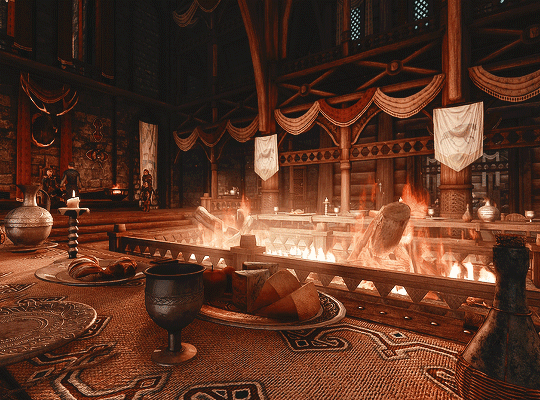
Prep: 15 minutes
Cooking time: 30 minutes
Pairs well with: rustic bread, good ale

Ingredients:
1 pound baby potatoes
2 tablespoons vegetable oil
1 pound ground beef or other meat
1/2 cup breadcrumbs
1 egg
1 tablespoon sour cream
1 garlic clove, minced
1/4 teaspoon stormcloak seasoning ( 2 tsp. dried dill, 1/2 tsp grains of paradise, 1 tsp. Mustard powder, 2 tsp. fennel seeds)
1 cup boiling water
1/4 cup sour cream
2-3 tablespoons tomato paste
Directions:
1. Preheat oven to 450°F & rub the potatoes all over with the oil, place them on a baking sheet & roast for about 15 minutes, until they are soft but not cooked all the way through.
2. While the potatoes are baking, make the meatballs by combining the ground meat, breadcrumbs, egg, sour cream, garlic, & stormcloak seasoning. Mix throughly & form into balls, roughly the size of the potatoes. When the potatoes are done, remove them from the oven & turn the heat down to 350F
3. Cut the potatoes roughly into 1/2 inch thick rounds, keeping the slices all together in a potato shape. Alternate the potatoes & meatballs in a casserole dish until the dish is full. Mix together the boiling water, sour cream, and tomato paste in a small bowl or measuring cup, then pour over the meatballs & potatoes until the liquid comes most of the way up the sides of the casserole dish, bake for 25-30 minutes or until meatballs are cooked through.
TIP:
These proportions make enough for 4 stalwart warriors, but the recipe can easily be scaled up for a larger gathering.

I hope you enjoyed this recipe more to follow soon,
Regards,
Culture Calypso’s Blog 🥔🧆🥔🧆
#my blogs#spotify#gaming#skyrim#cooking#elder scrolls#paganism#taverncore#cottagecore#medival#rustic#celtic#vikings
16 notes
·
View notes
Text
Today’s recipes of Skyrim blog is…
Baked White River Salmon
🏞🐟🏞🐟🏞🐟🏞🐟🏞🐟🏞🐟🏞🐟🏞🐟🏞🐟
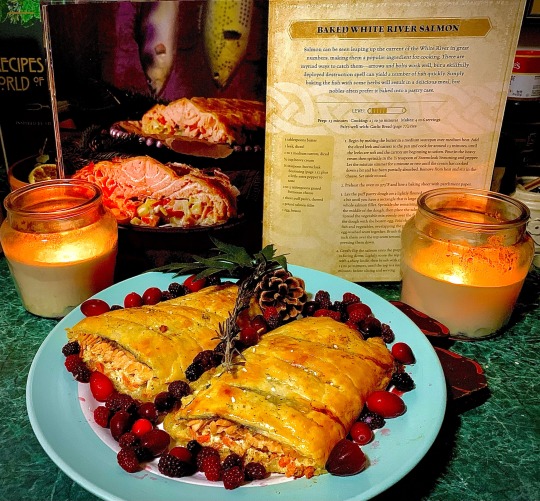
Salmon can be seen leaping up the current of the white river in great numbers, making them a popular ingredient for cooking. There are myriad ways to catch them-arrows and bolts work well, but a skillfully deployed destruction spell can yield a number of fish quickly, simply baking the fish with some herbs will result in a delicious meal, but nobles often prefer a baked into a pastry case.
BLOGGER NOTE: I used a pie crust & baked for around 50 minutes the last 10-12 at 400° I didn’t use a leek & I added cranberries & blackberries & a sprig of rosemary
Prep: 15
Cooking: 25-30 minutes
Makes: 4-6 servings
Pairs well with: Garlic bread & rice
Ingredients:
3 tablespoons butter
1 leek diced
1 to 2 medium carrots diced
1/4 cup heavy cream
1/2 teaspoon stormcloak seasoning (2 tsp. Dried dill, 1/2 teaspoon grains of paradise, 1 teaspoon mustard powder, 2 teaspoons fennel seeds) plus pepper to taste.
2 to 3 tablespoons grated Parmesan cheese,
one sheet puff pastry thawed
1 pound salmon fillet
one egg, beaten
Directions:
1. Begin by melting the butter in a medium saucepan over medium heat. Add the diced leek and carrots to the pan and cook for around 15 minutes until the leek is soft and the carrots are beginning to soften. Pour in the heavy cream then sprinkle in the 1/2 teaspoon of Stormcloak seasoning and pepper. Let the mixture simmer for a minute or two until the cream has cooled down a bit and has been partially absorbed. Remove from heat and stir in the cheese. Set aside to cool.
2. Preheat the oven to 375°F in line a baking sheet with parchment paper.
3. Lay the puff pastry dough on a lightly floured surface. Roll out the dough a bit until you have a rectangle that is large enough to wrap around the whole salmon fillet. Sprinkle the remaining Stormcloak seasoning over the middle of the dough, then place the salmon on top of the seasoning. Spread the vegetable mix evenly over the fish, then brush the edges of the dough with the beaten egg. Fold the long sides of the pastry over the fish and vegetables, overlapping the pastry in the middle, then press the egg wash-seam together. Brush the sides of the pastry with egg and tuck them over the top seam towards the middle as far as they will go, also pressing them down.
4. Gently flip the salmon into the prepared baking sheet so the seam is facing down. Lightly score of the top of the dough only partway through with a sharp knife, then brush with the remaining egg. Bake for about 25 to 30 minutes, until the top is a nice golden brown. Let cool for a few minutes before slicing and serving.
I hope you enjoy this blog more to follow,
Culture Calypso’s’s blog 🐟🏞

8 notes
·
View notes
Text
Today’s recipes of Skyrim Blog is…
Horker Loaf
🍖🥓🍖🥓🍖🥓🍖🥓🍖🥓🍖🥓🍖🥓🍖🥓🍖🥓

Well Horker meat might not be everyone’s first pick, it sustains many a coastal family. It’s considered lucky to eat the roasted garlic “tusks” at the top of the loaf, and children will often compete with one another to get them.
Prep: 10 minutes
Cooking: 40 minutes
Makes: 1 loaf 4-6 servings
Pairs well with: double baked potatoes, baby carrots in moonsugar glaze, imperial mushroom sauce
Ingredients:
One 3.75-ounce tin smoked oysters (optional)
5 cloves of garlic, divided
1 large carrot, peeled & chopped
1 1/2 pounds ground beef
1/2 cup breadcrumbs
1/3 cup heavy cream
1 egg
1 teaspoon stormcloak seasoning (2 teaspoons dried dill, 1/2 teaspoon grains of paradise, 1 tsp mustard powder, 2 teaspoons fennel seeds)
1 teaspoon salt
1 teaspoon pepper
5 bacon slices
Instructions:
1. Preheat the oven to 425°F & Line a baking sheet with parchment paper.
2. Mince 2 cloves of the garlic, then pulse the oysters, minced garlic, and carrot several times in a food processor until there are no large chunks. In a large bowl, combine the mixture with the ground beef, bread crumbs, heavy cream, egg, stormcloak seasoning, salt, and pepper. Mix thoroughly, and form into a slightly oblong dome no higher than 4 inches, on the prepared baking sheet.
3. Gently press the 3 remaining garlic cloves into the top of the loaf. Then, working from just next to the garlic, begin laying the bacon slices across the short side of the loaf, 2 on each side. Lay one final strip over the garlic to keep it from burning.
4. Bake for about 40 minutes. Peel back the top piece of the bacon to reveal the garlic tusks before serving.
I hope you enjoyed this blog more to follow soon
Regards,
Culture Calypso’s Blog 🥓🍖

3 notes
·
View notes